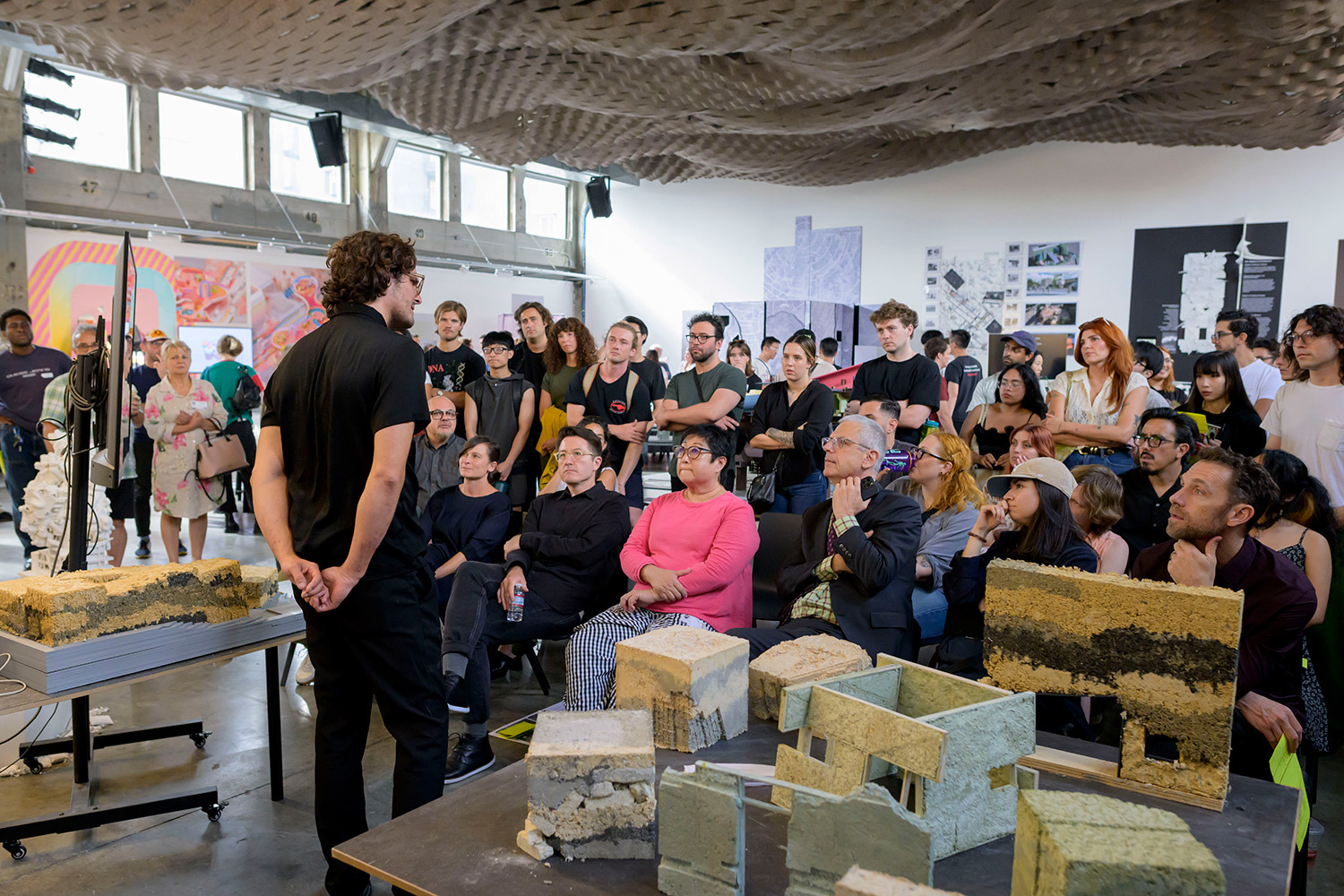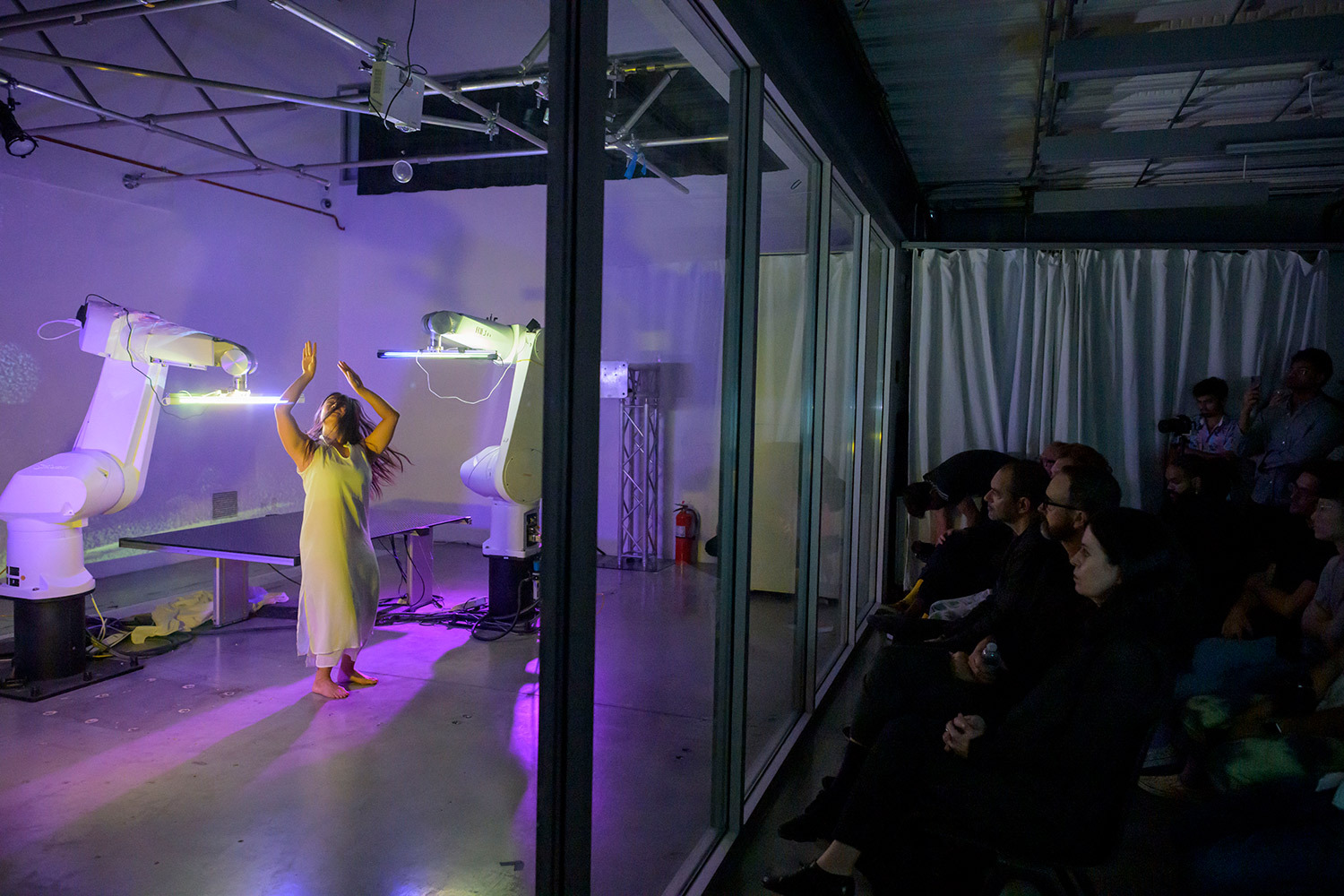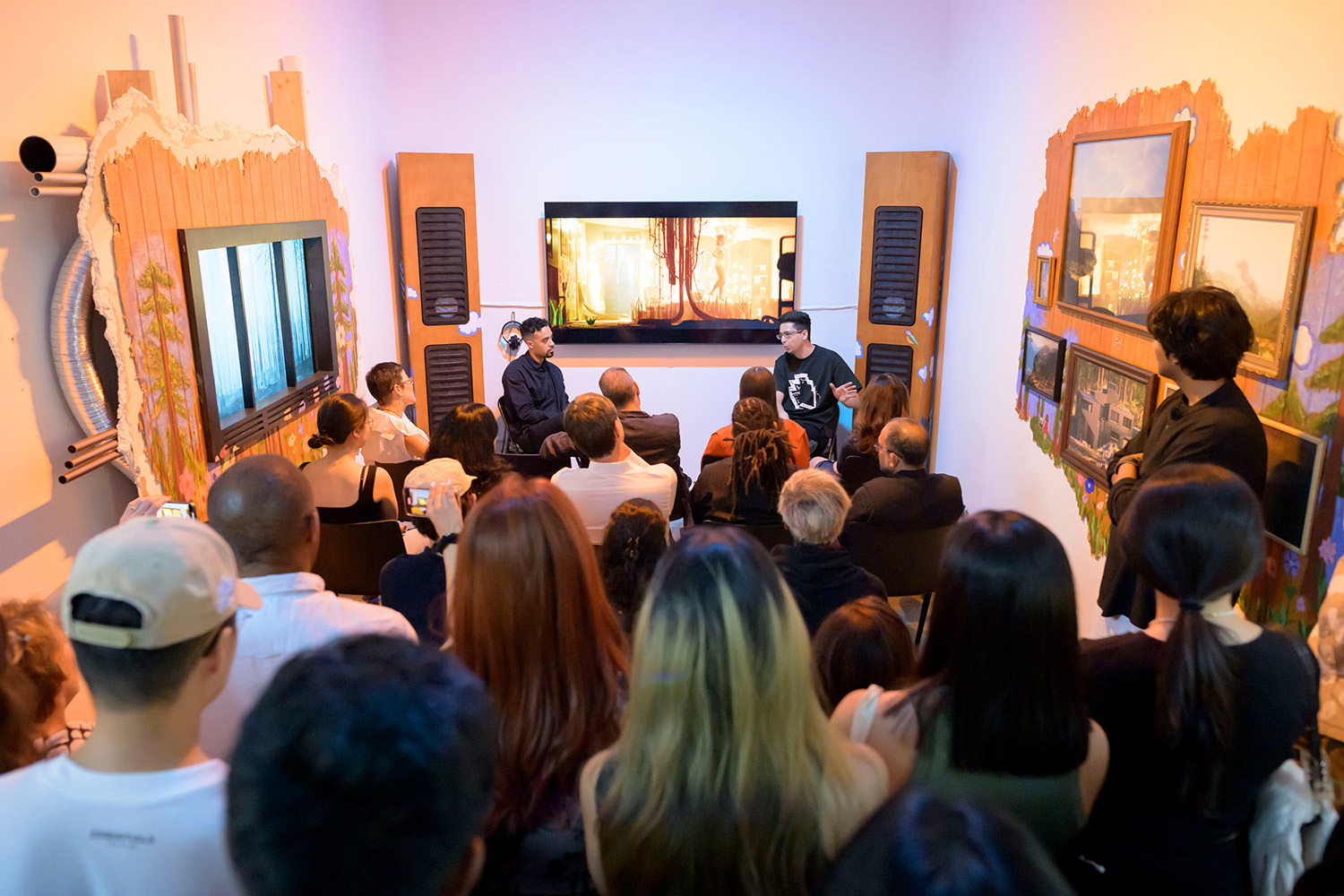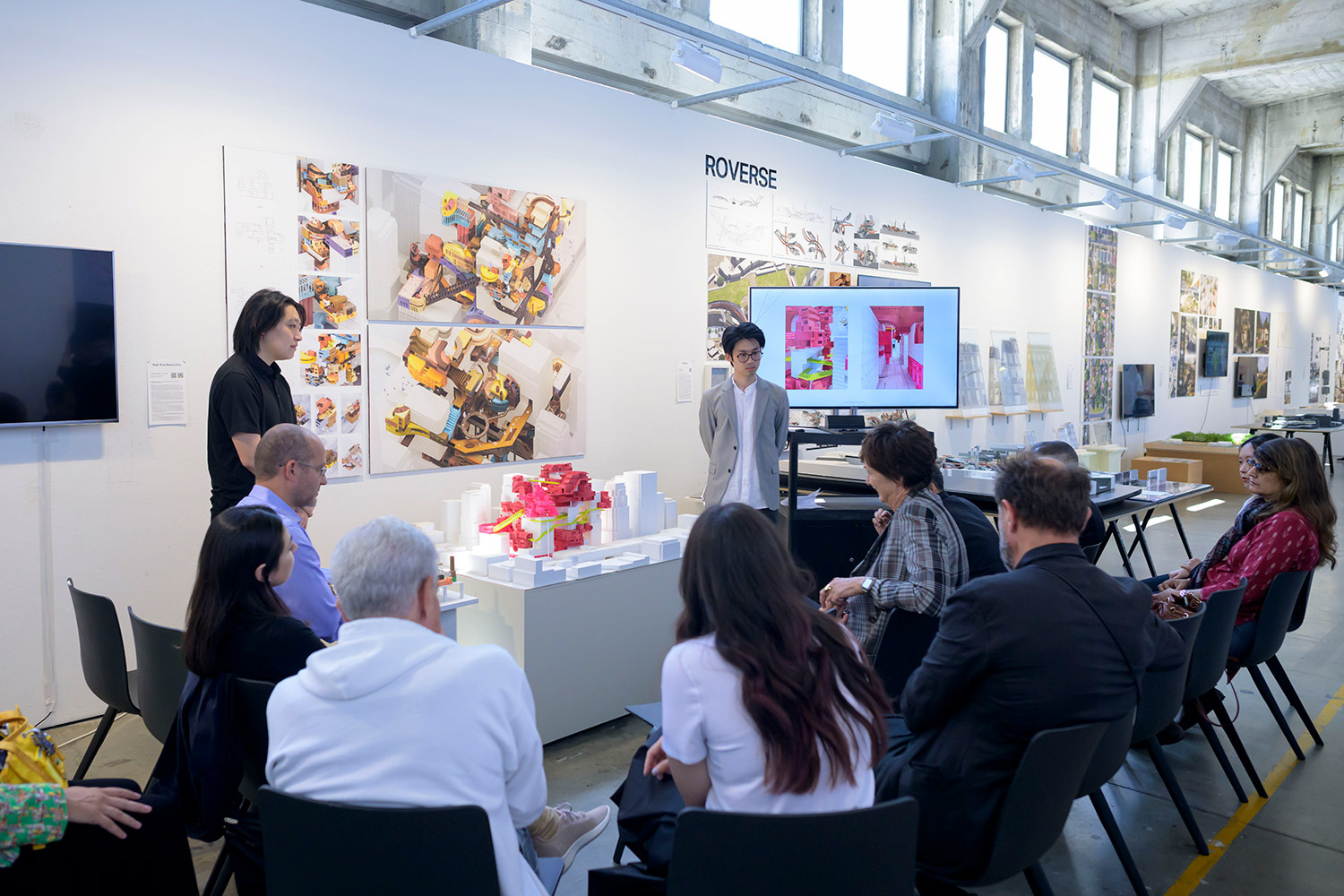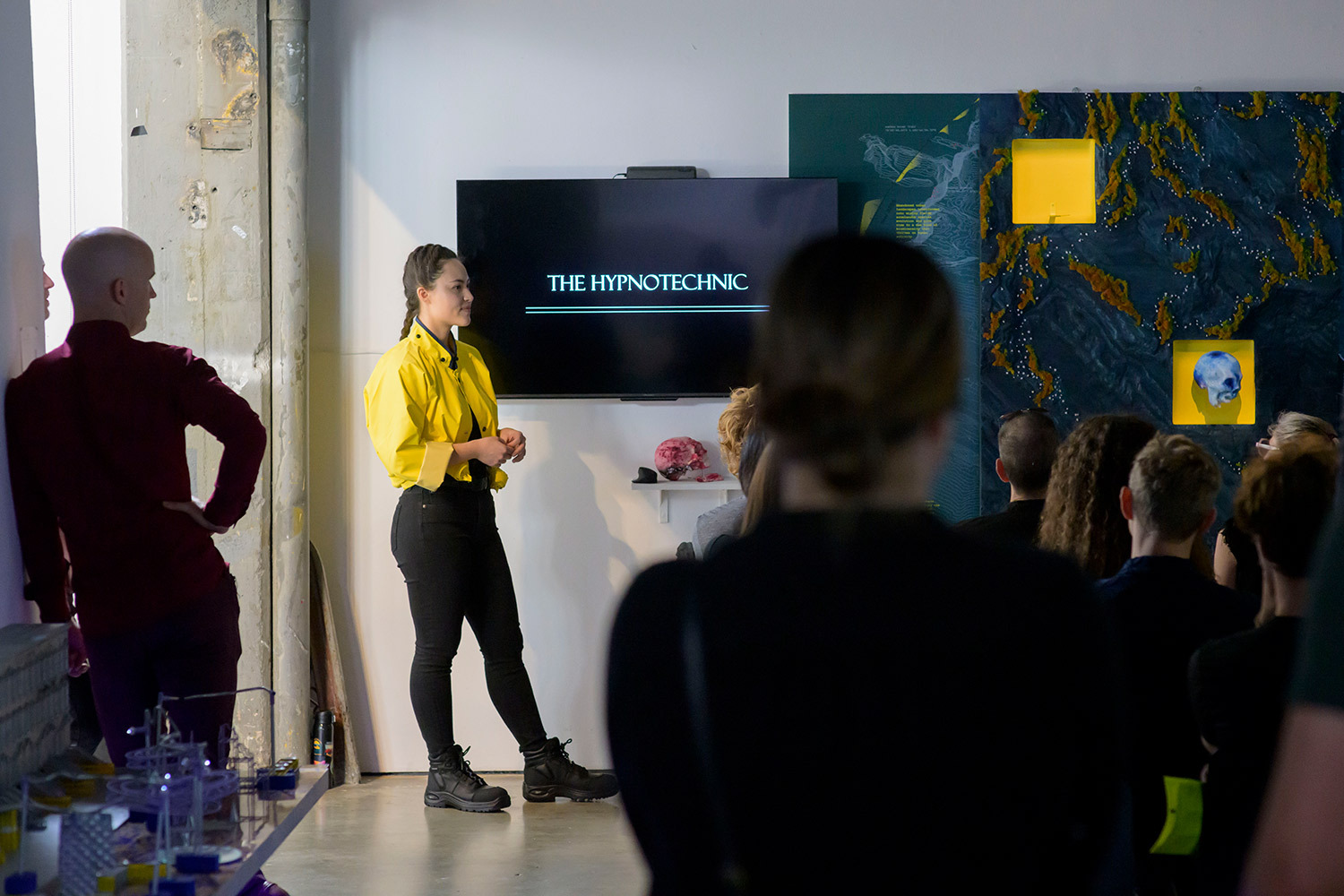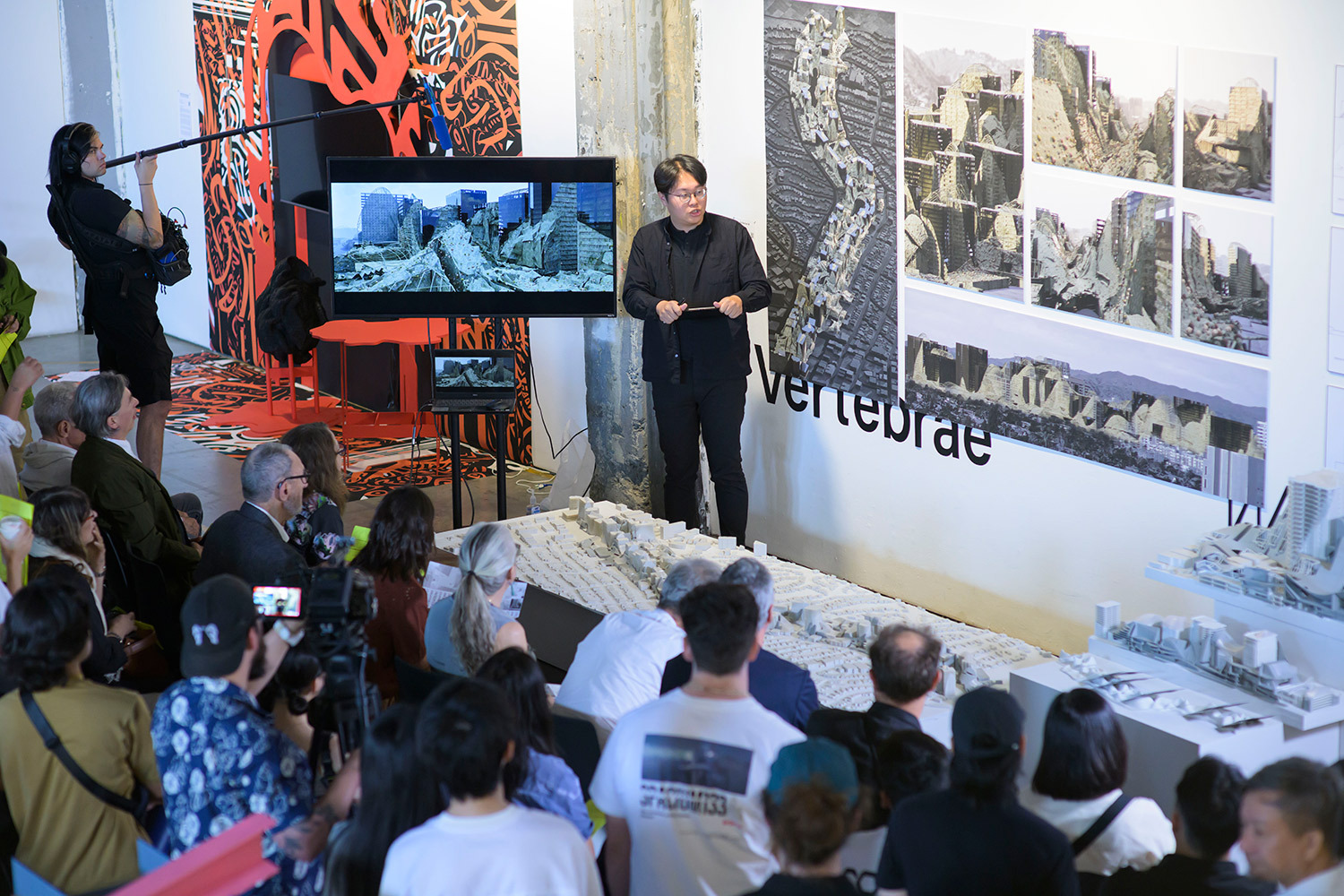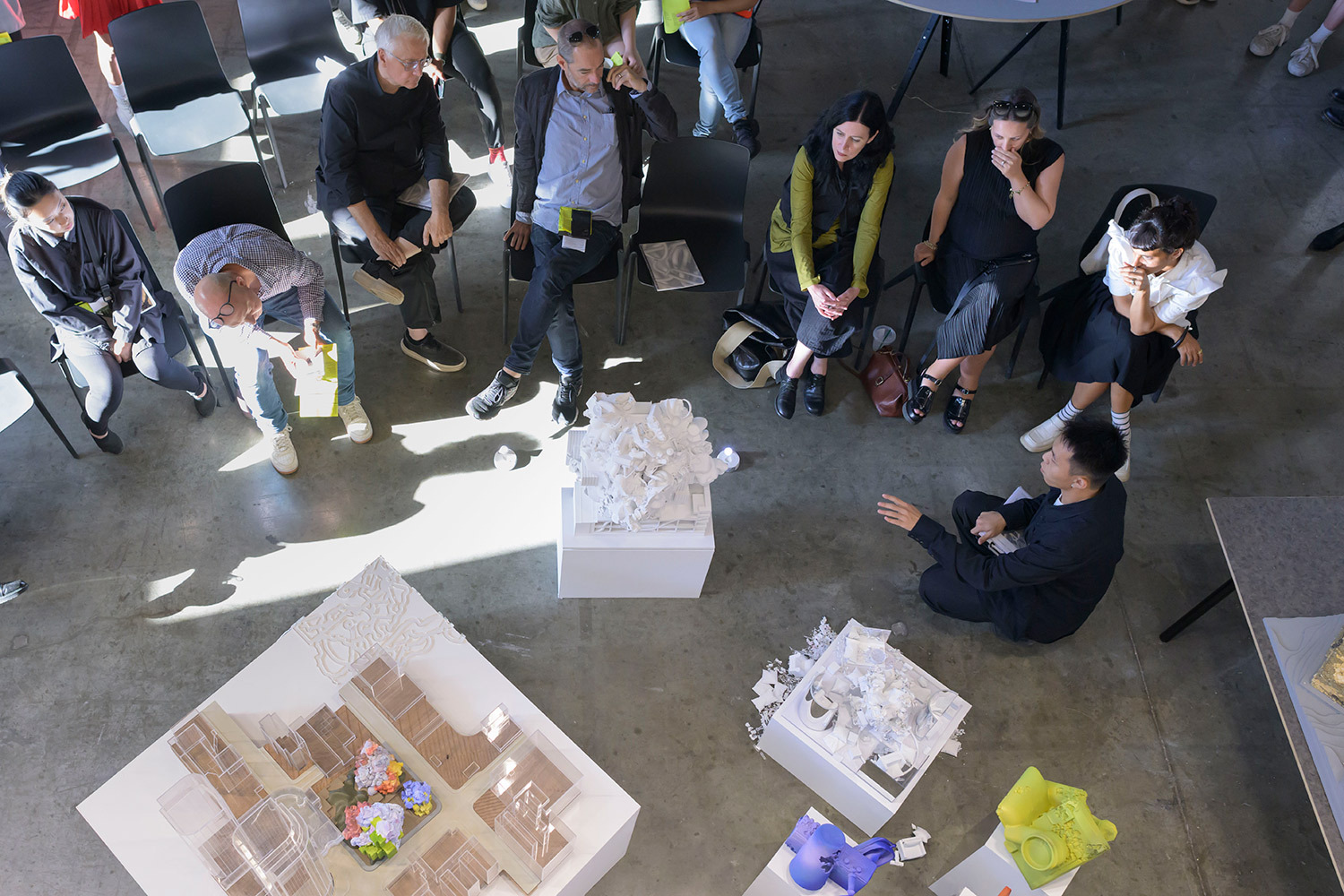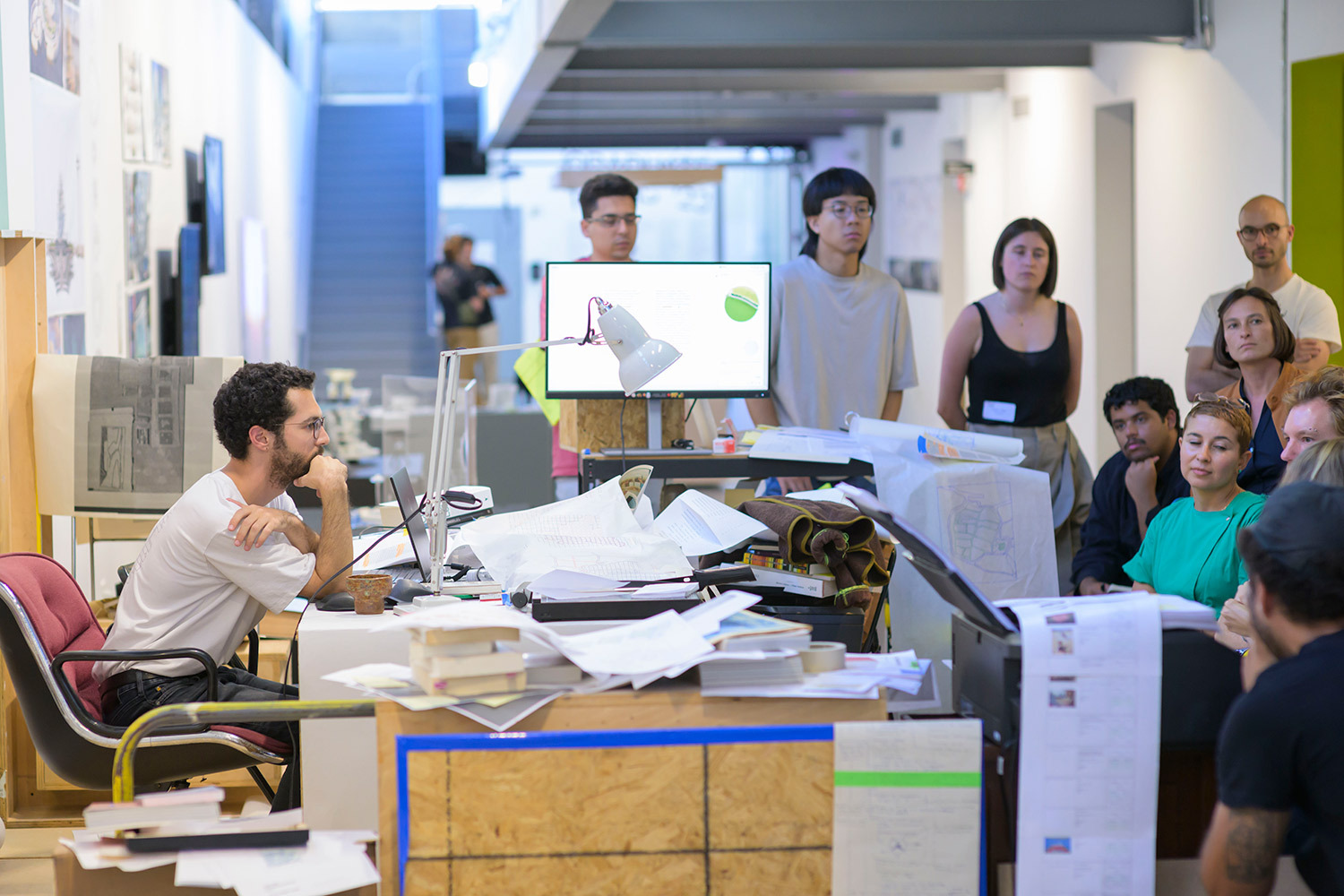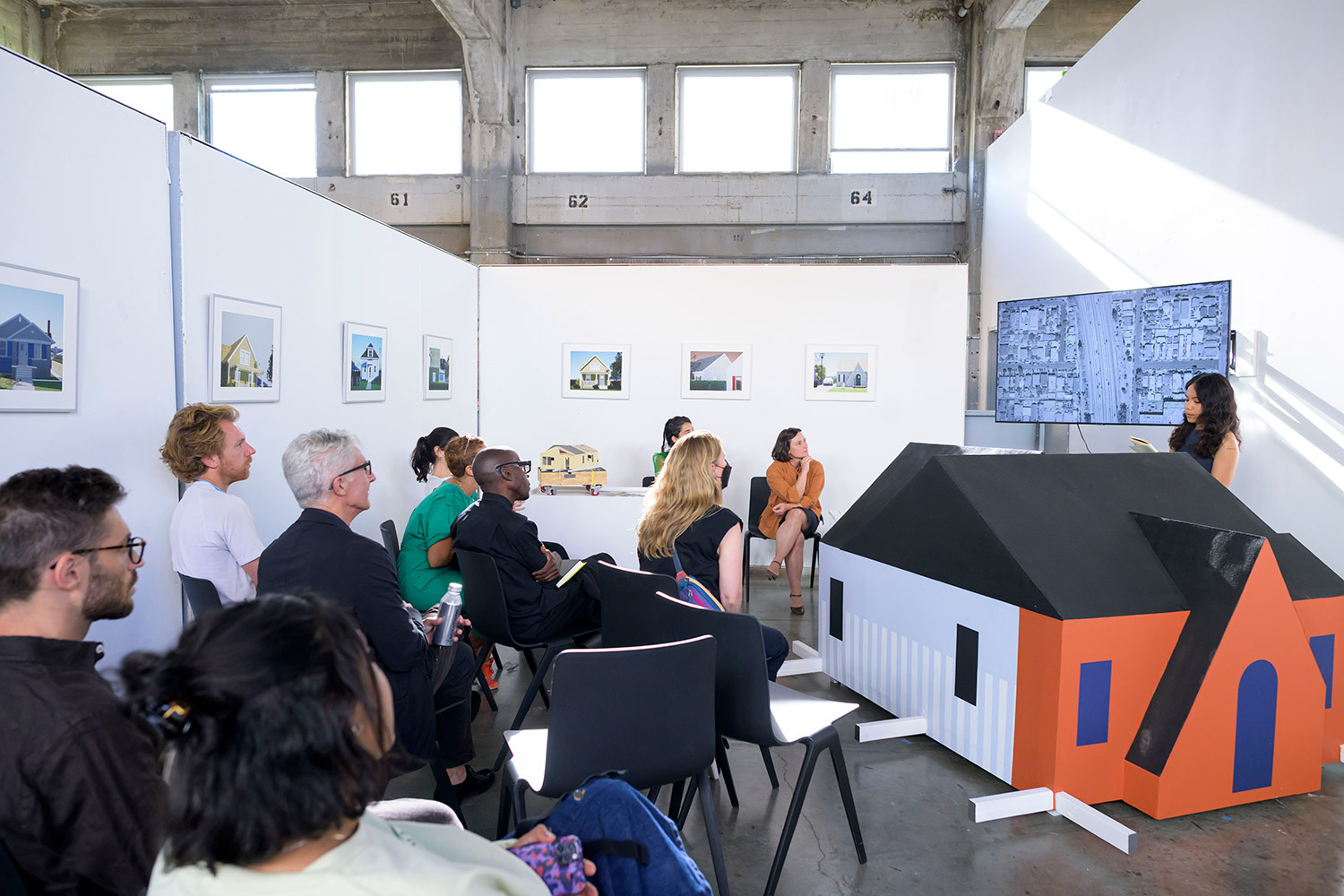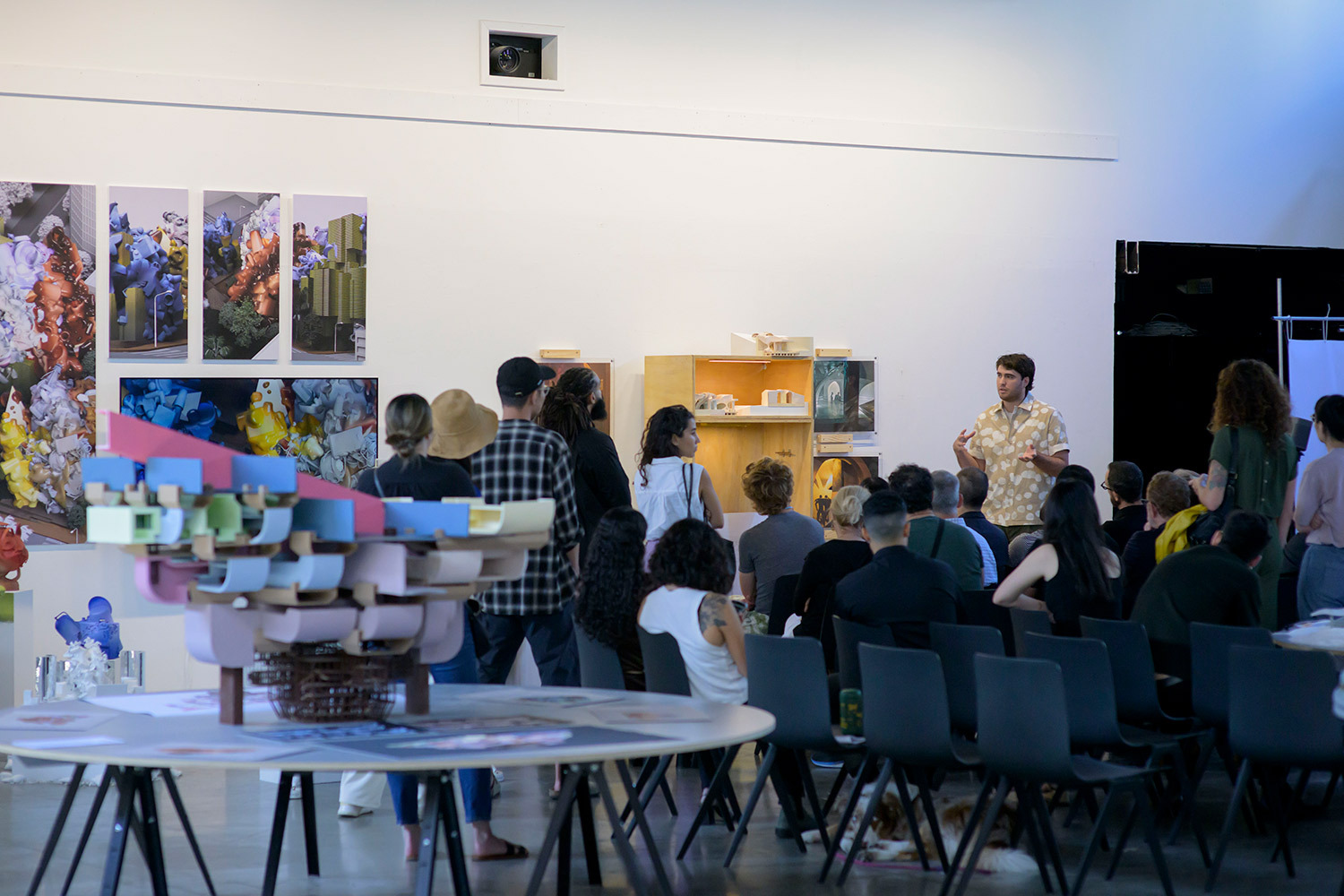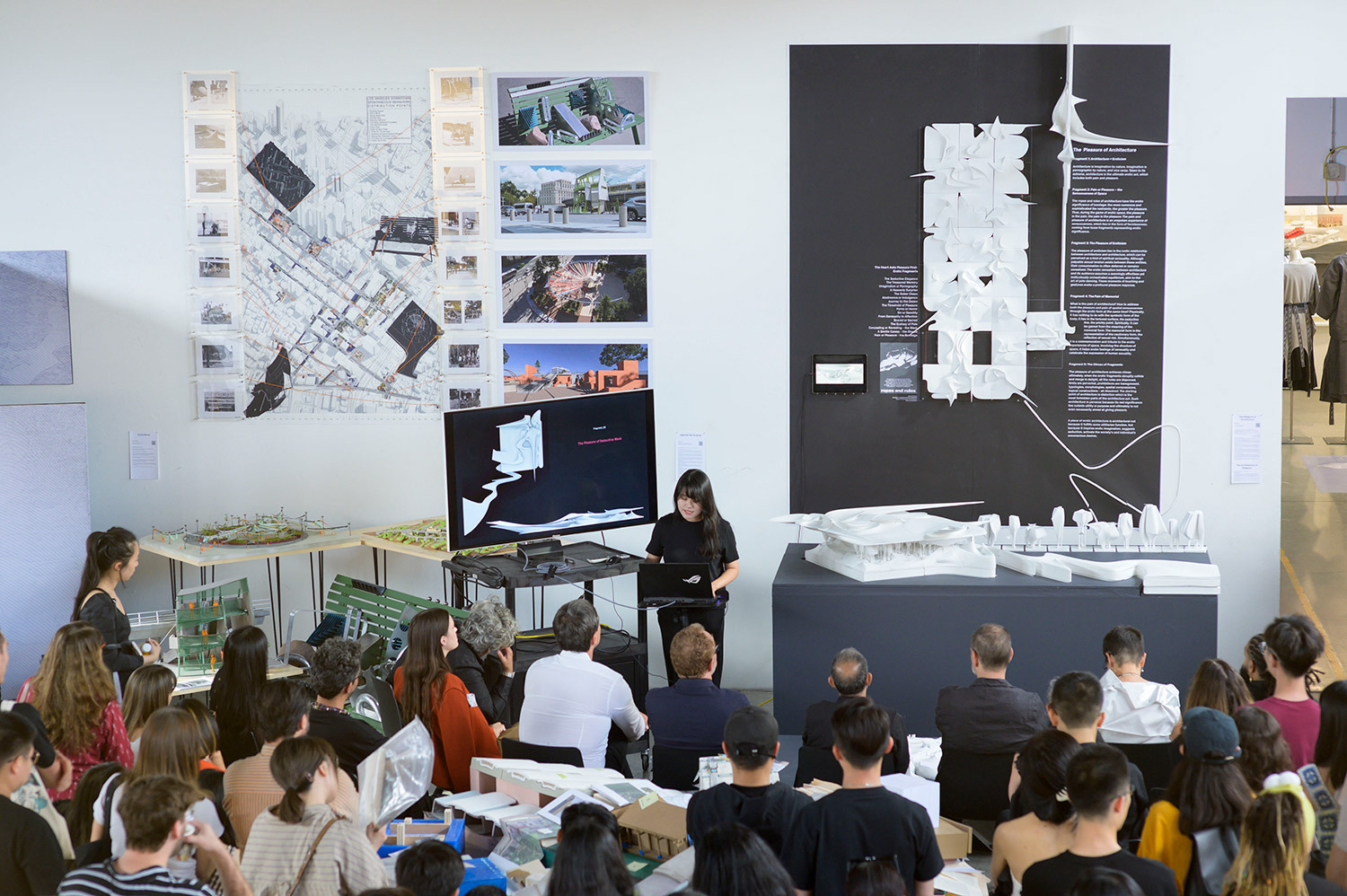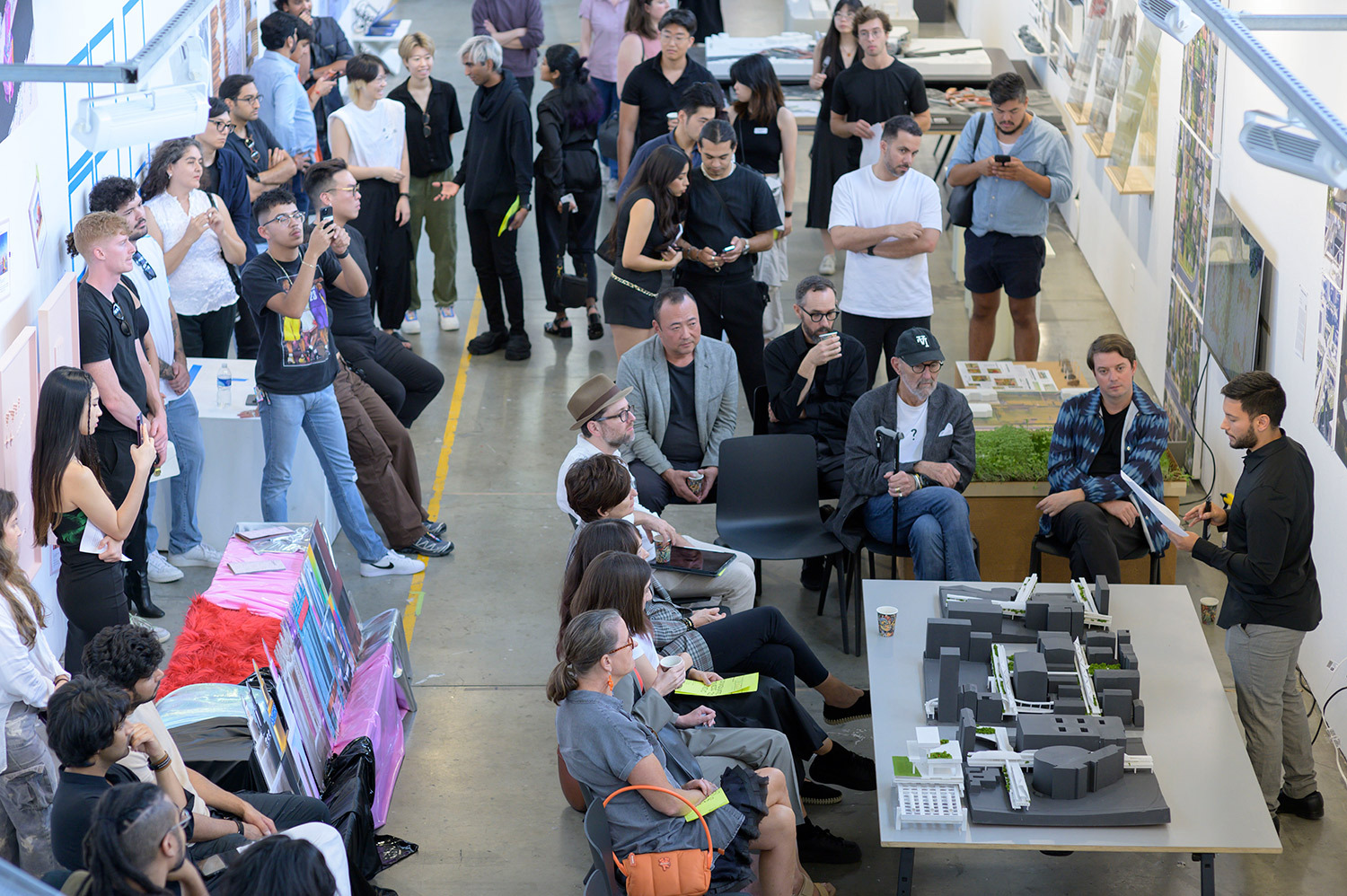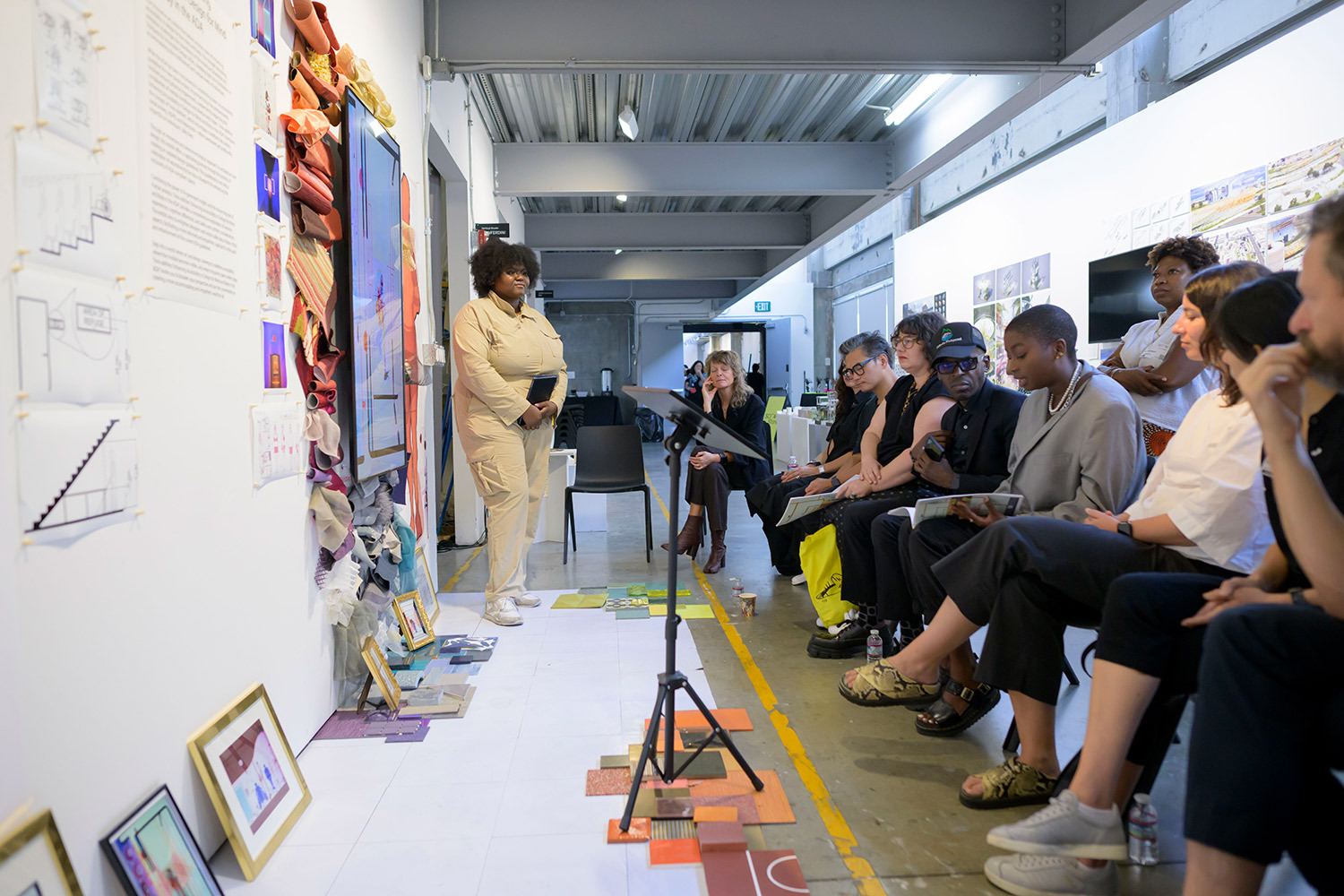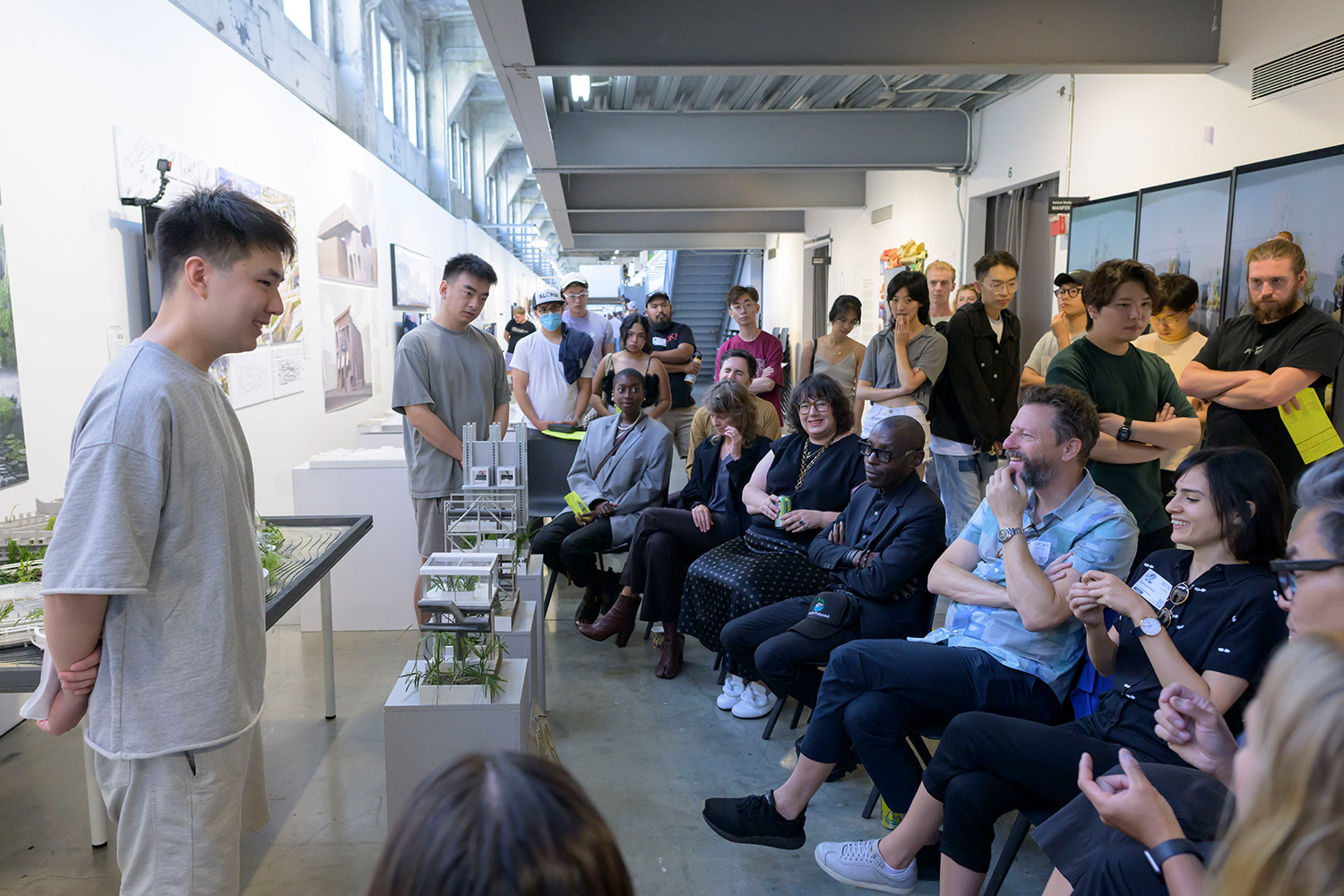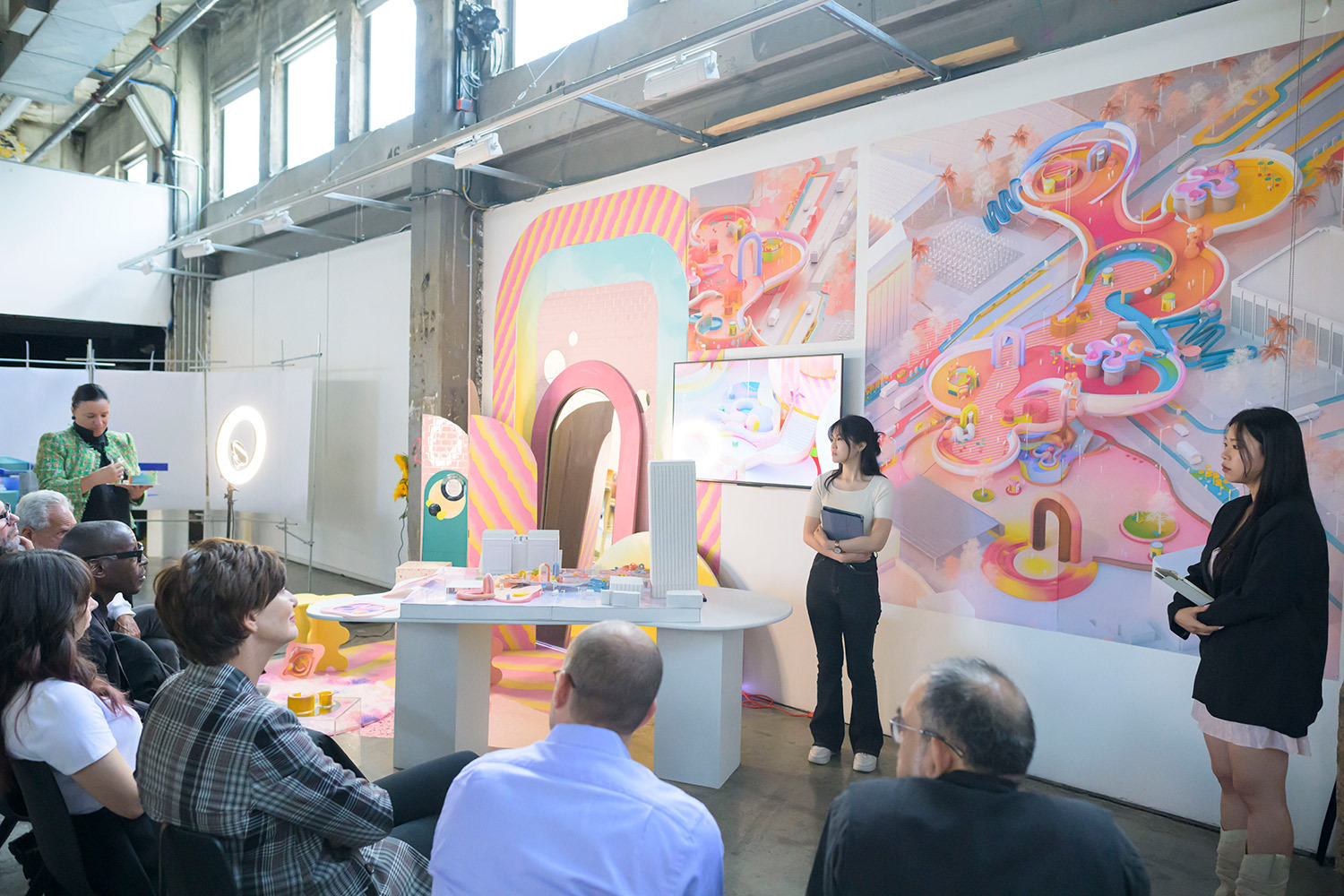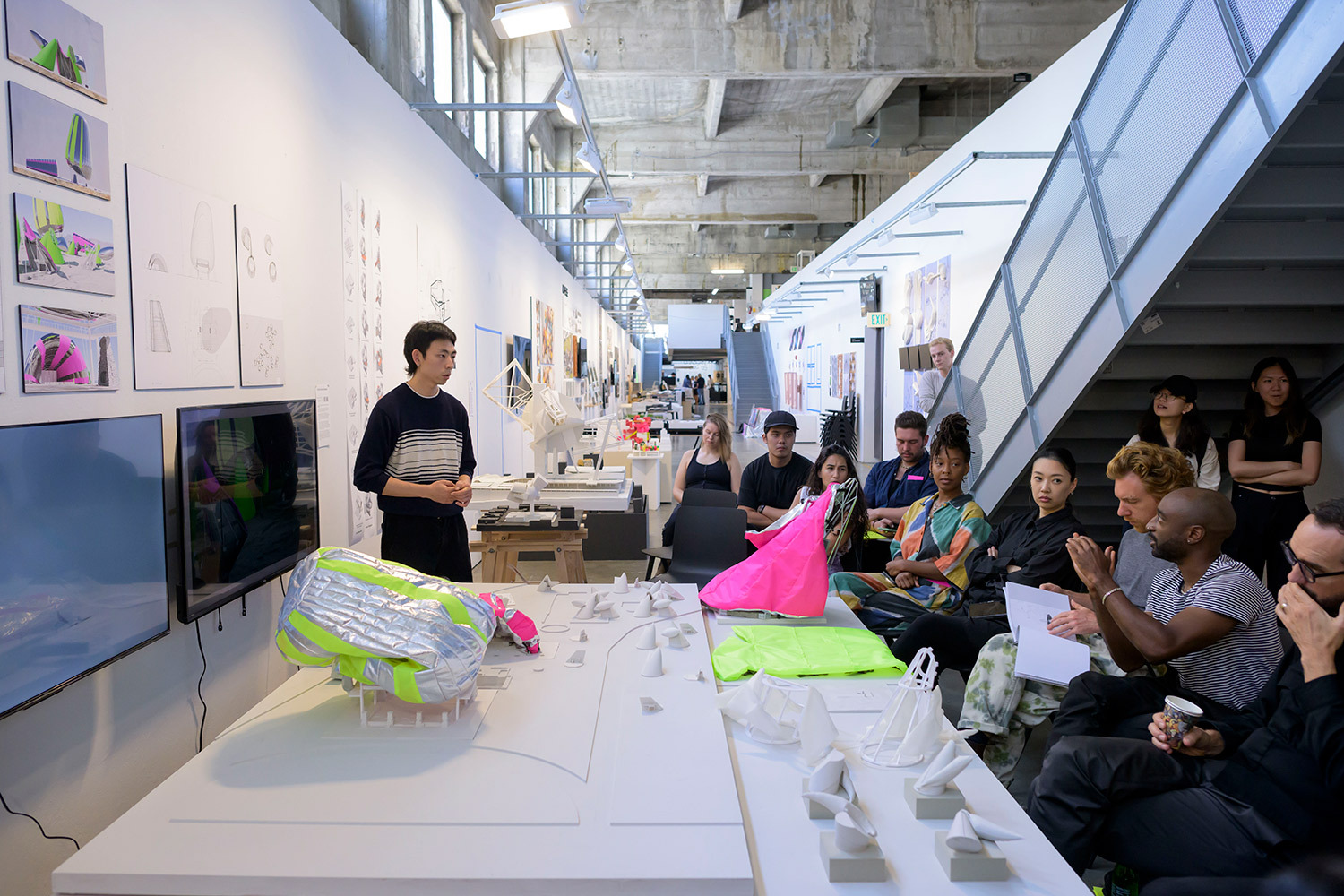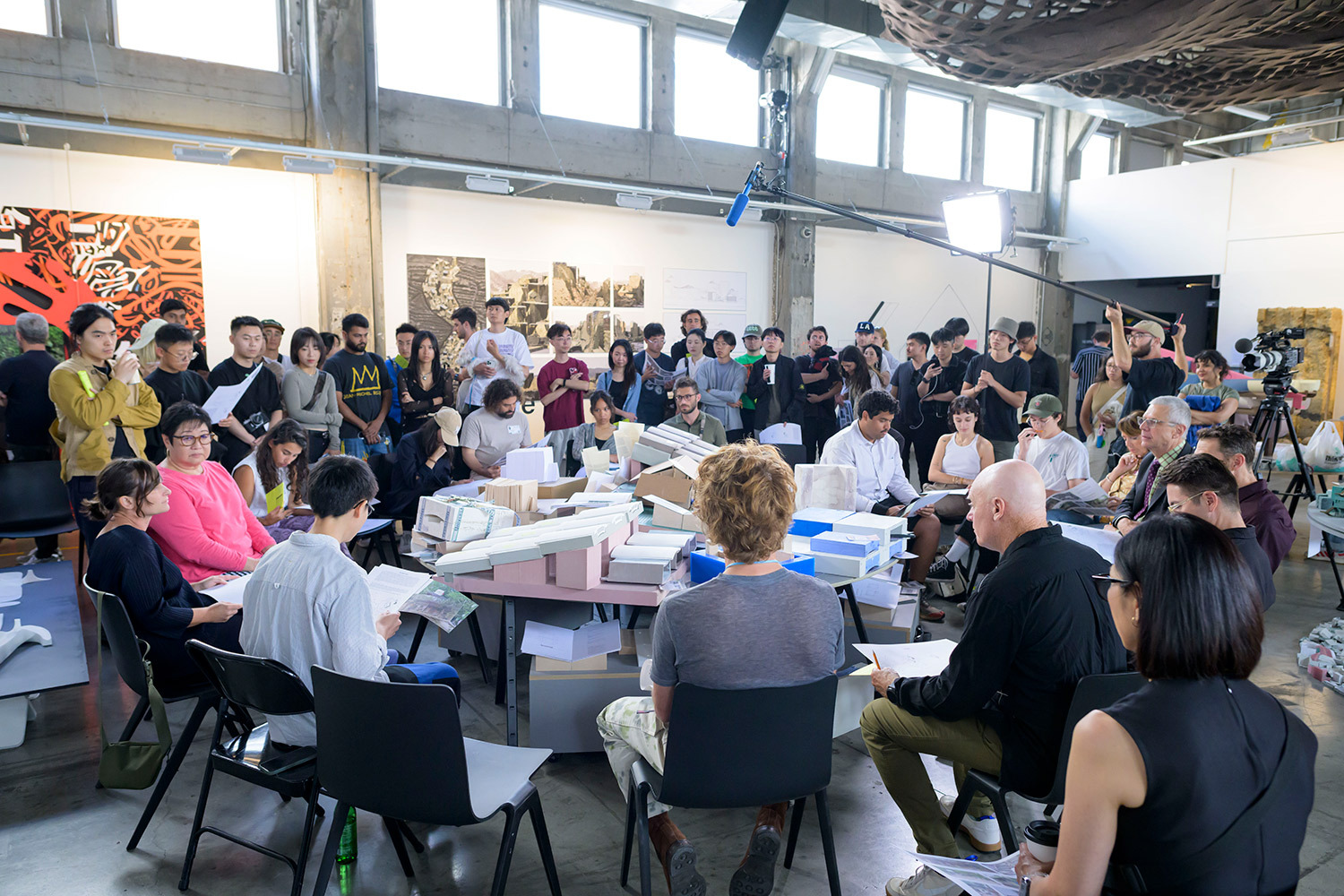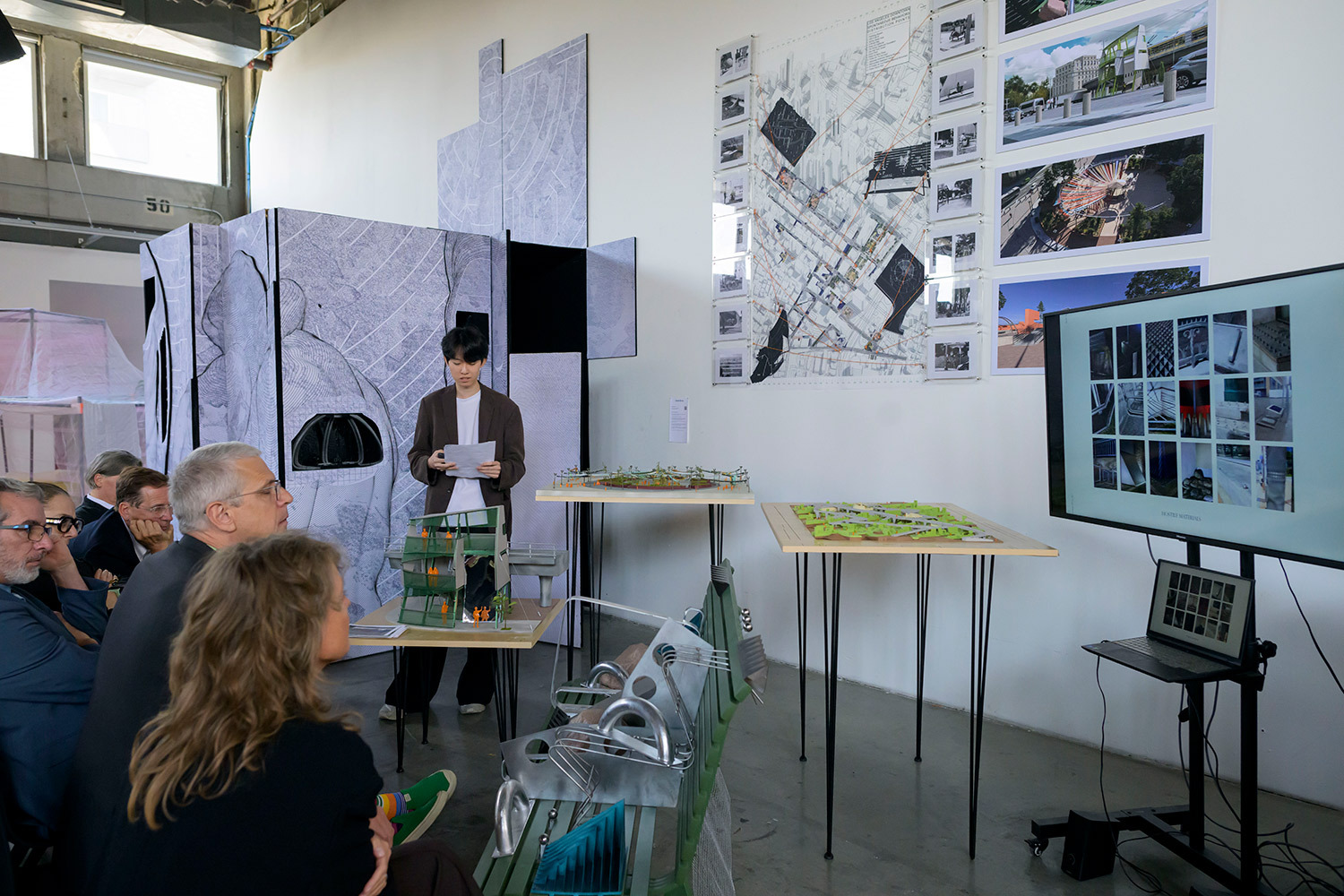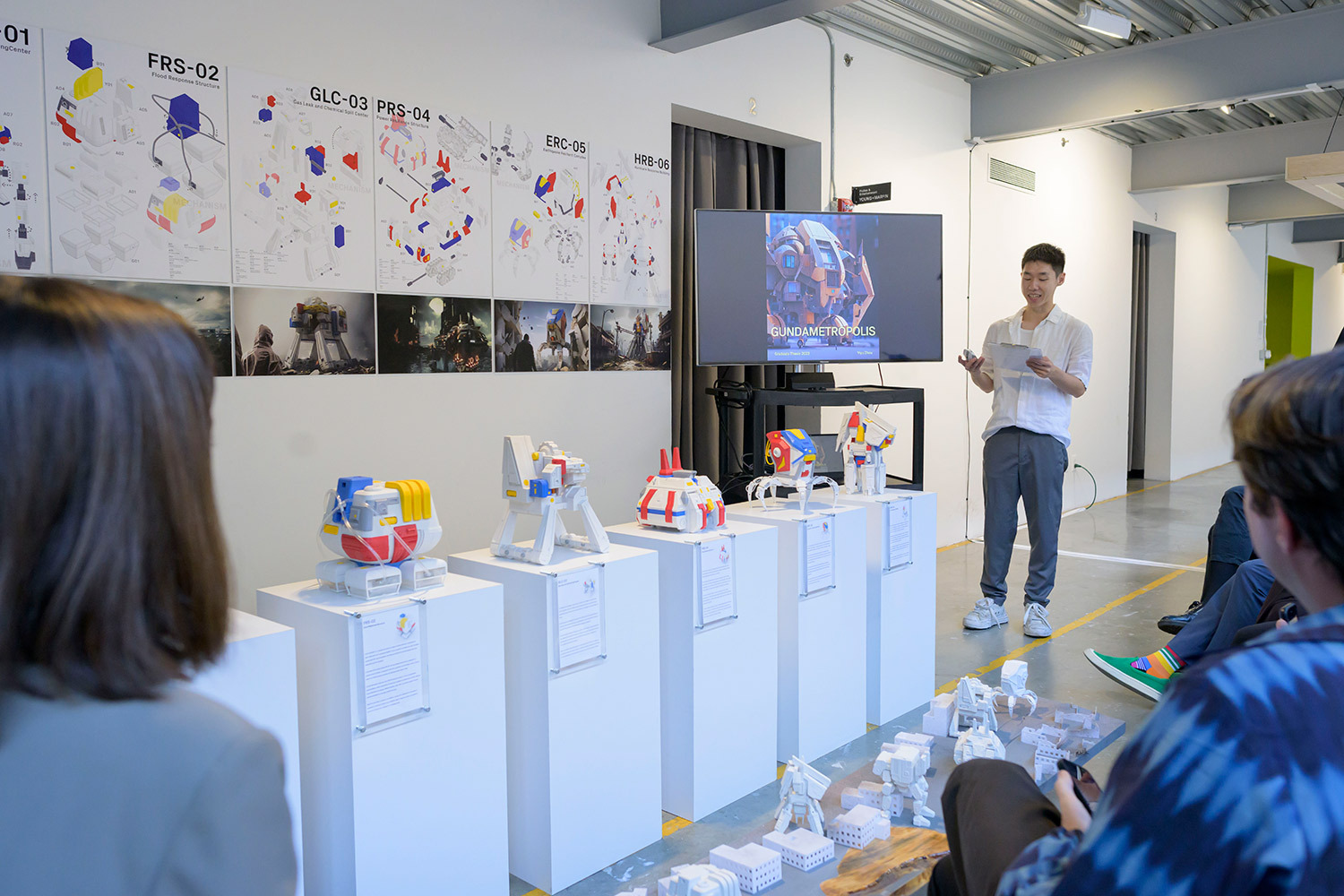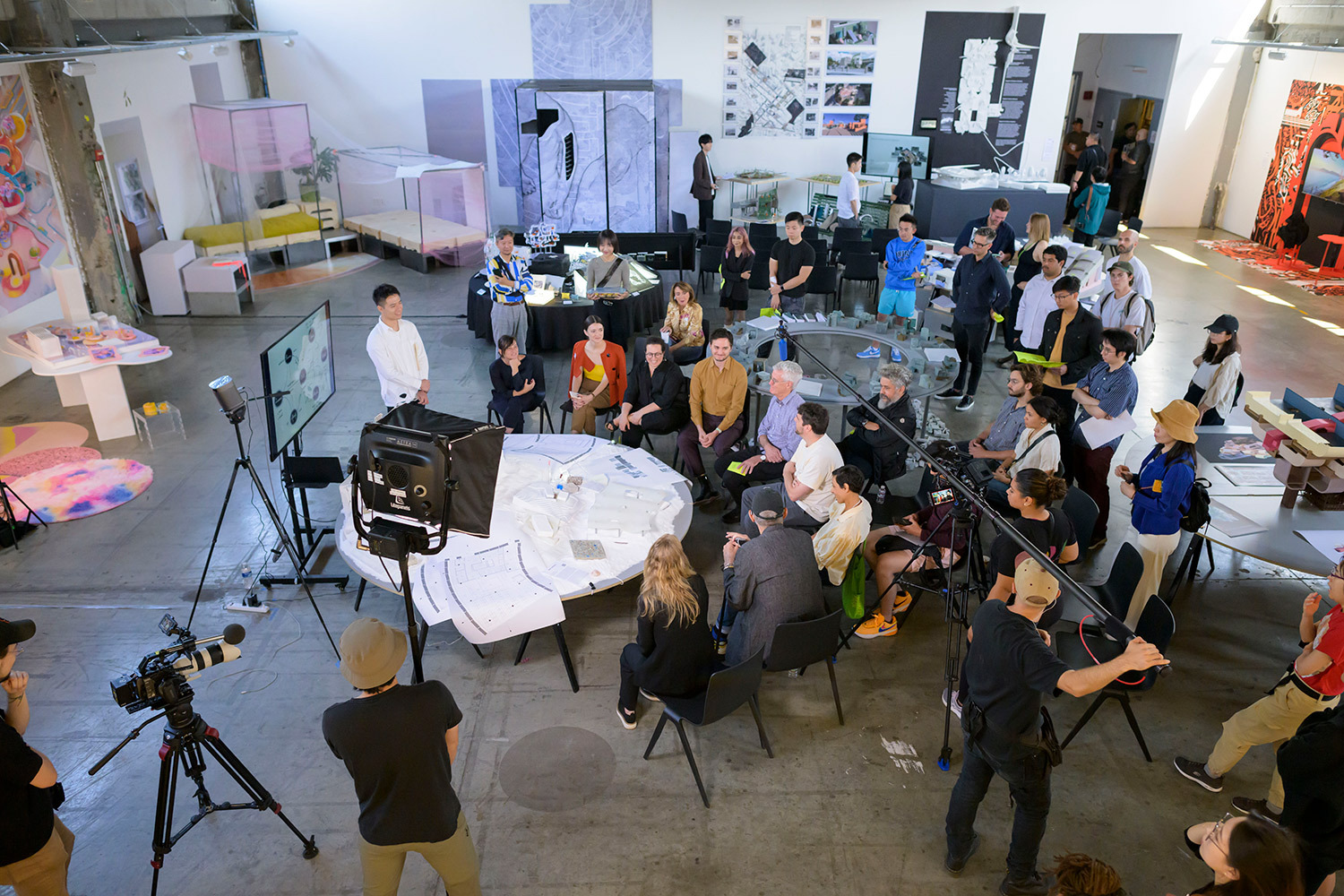Grad Thesis 2023 Reinvigorates Inquiry into Building as Material and Form
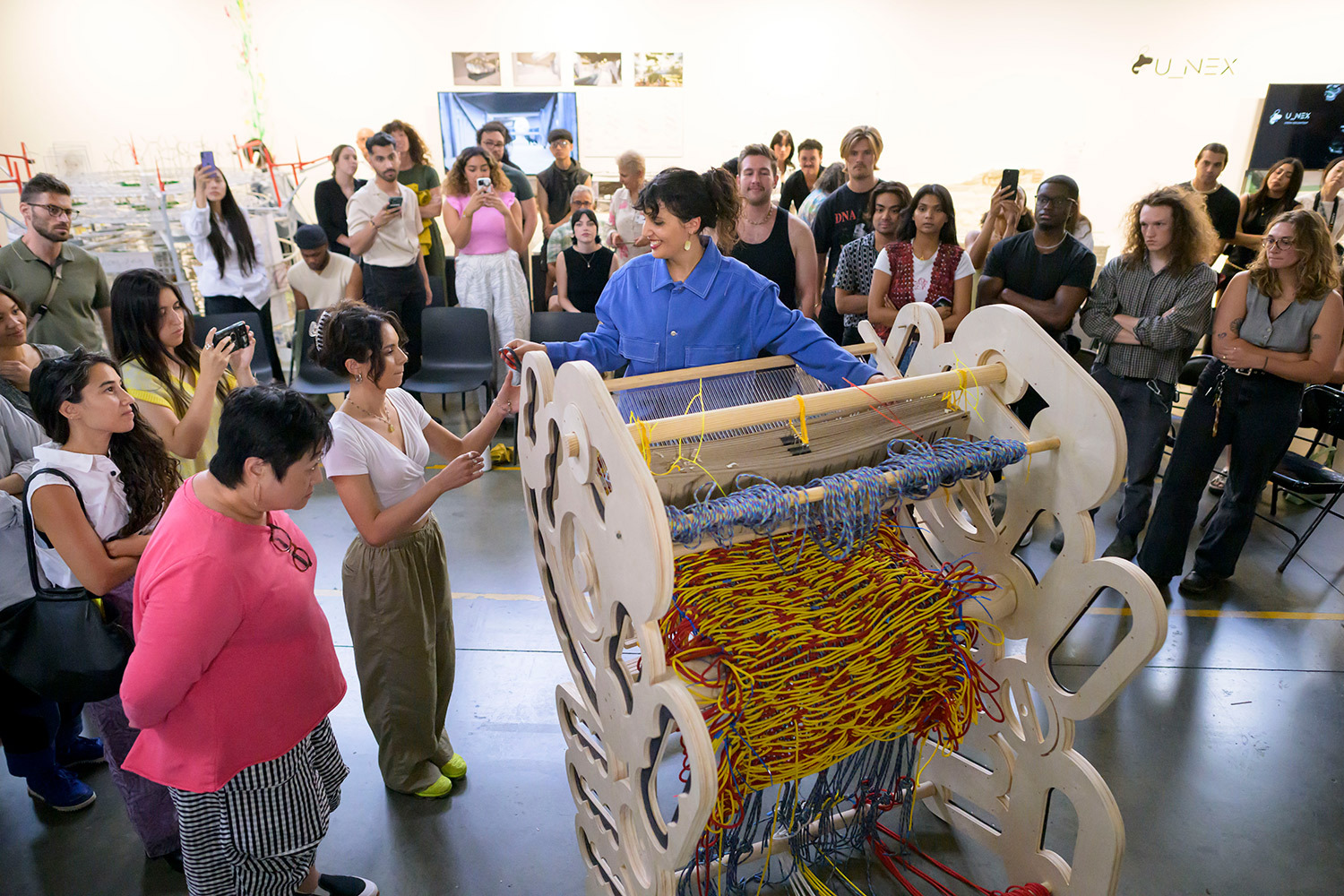
Graduate Thesis 2023 at SCI-Arc recently concluded a weekend of final reviews, marking an impressive display of innovative thinking and deep insight into the multifaceted challenges of our built environment by M.Arch 1 and M.Arch 2 graduates. The projects showcased were not only grounded in addressing the social, technological, and climatic challenges we continue to face by transcending traditional problem-solving methods. Instead, they introduced novel design processes and intellectual frameworks, reflecting a forward-thinking approach in architectural design with each thesis representing a unique and personal journey, mirroring the diverse interests and talents of the 2023 graduating class.
“The collective impact of these projects was significant,” commented Graduate Thesis Coordinator Jackilin Hah Bloom—sparking stimulating discussions and debates among over 80 guest critics throughout the event. Notable highlights included full-scale representation of projects that meticulously test materials and processes of crafting and making, alongside digital reconceptions of urban conditions in the face of climate change, and proposals that challenged the traditional notions of buildings and space through combinations of multi-media and physical models.
Standing collectively as visionary proposals, demonstrating the students' ability to think critically and creatively about the future of architecture and its societal implications, “this year's graduate thesis showcase at SCI-Arc transcended mere academic achievement,” continued Bloom. “It represented the evolving role of architects and designers in shaping a future that is technologically advanced, socially conscious, and ecologically sustainable, inspiring optimism among attendees about the innovative directions the field of architecture is pursuing.”
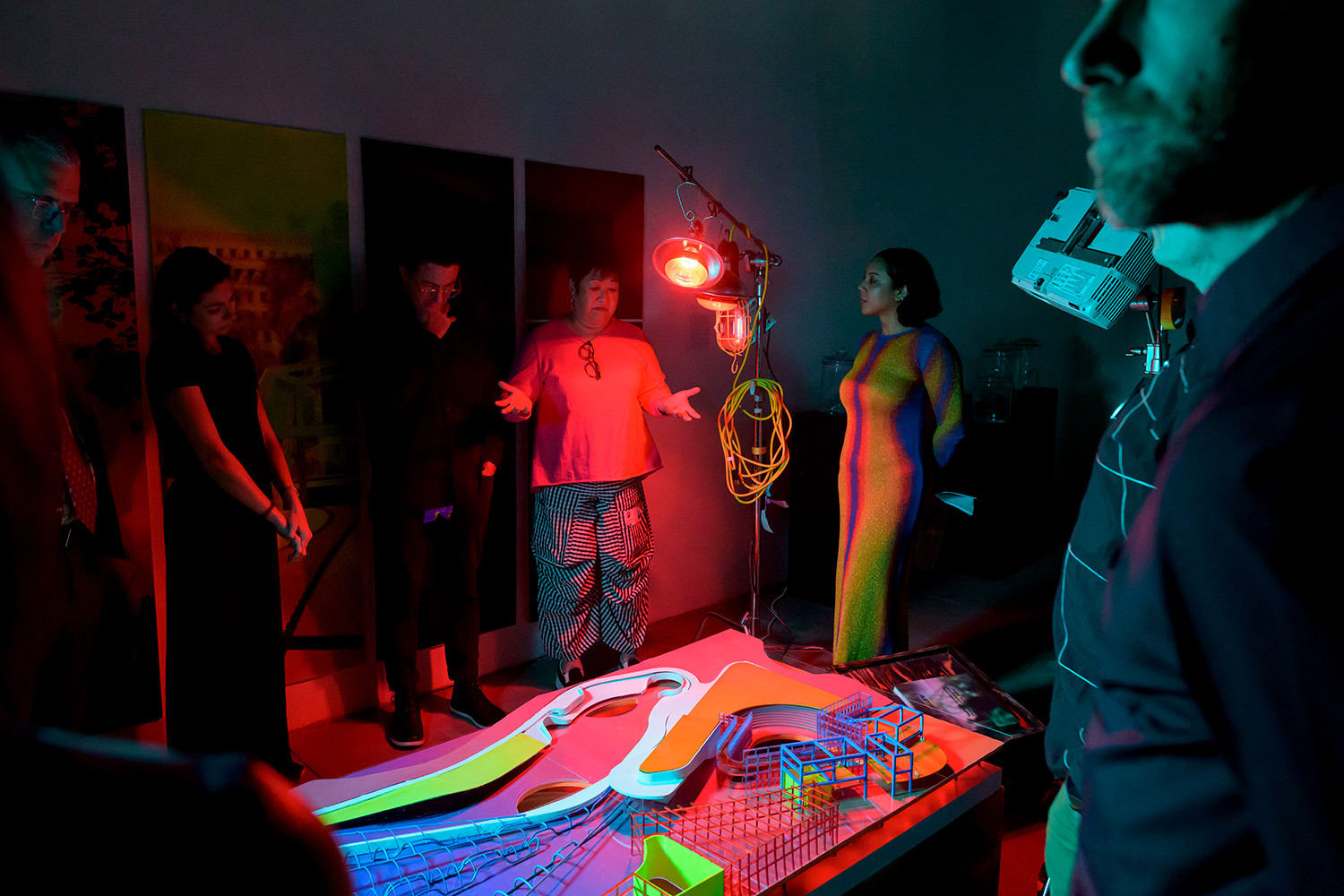
The prominent themes shaping thesis projects included the interplay of AI and imagination, the impactful nuances of ecology, and the role of ‘building’ as tangible materials and forms, and as embodiments of constructing ideas. “What was striking for me was to see during thesis weekend was the level of self-confidence and self-expression of the students. There are several factors that contribute to the development of a strong academic community, including supportive teachers and peers, opportunities for self-discovery and exploration, and a positive and inclusive school culture,” shared Graduate Programs Chair Elena Manferdini.
“When students have high self-confidence, they are more likely to take on challenges, set ambitious goals, and persist in the face of setbacks,” she said. “This can lead to greater academic achievements and personal development. It's important to continue to provide them with opportunities and support to nurture these attributes, as they will serve them well in their future endeavors.”
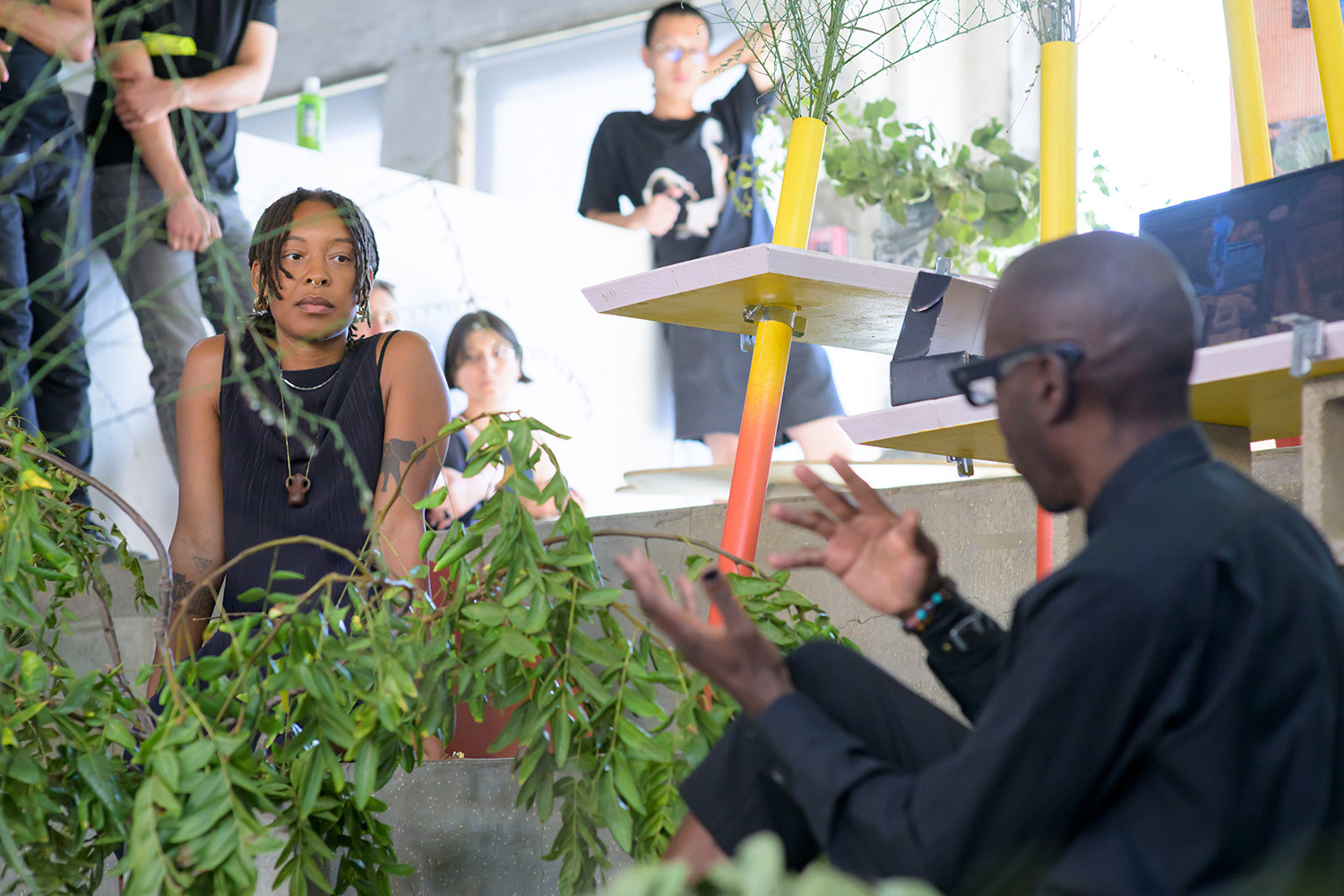
Noteworthy projects recognized as outstanding included this year’s Gehry Prize Winners Charite Carballo (M.Arch 1 ‘23) and Man Shu (M.Arch 2 ‘23), as well as by the Merit Thesis Award Winners Edwin MacKenzie Masson Champlin (M.Arch 1 ‘23), Jingbo Huang (M.Arch 1 ‘23), Matthew Ross Hunt (M.Arch 1 ‘23), Matthew Pak (M.Arch 1 ‘23), Pan Tan (M.Arch 1 ‘23), Jenny Cook + Hanna Park (M.Arch 2 ‘23), Kristoff Sebastian Fink + Felix Alexander Reyes (M.Arch 2 ‘23), Jack London Freedman (M.Arch 2 ‘23), Arthur Thomas Modine (M.Arch 2 ‘23), and Yiyu Zhou (M.Arch 2 ‘23). Full list of recipients below.
To view all of this year’s student projects, visit the official Graduate Thesis 2023 website.
Merit Graduate Thesis Awards
In recognition of an outstanding graduate thesis project.
Mackenzie Champlin (M.Arch 1)
Advisor: Ramiro Diaz Granados
@mack.champlin
Abruptly Laid to Rest
Landscape, Infrastructure, Remediation
A wave of more incendiary climate activism, from spraying paintings with soup to attacking infrastructure, has begun to emerge. Some may call them climate extremists; some may call them realists. We may find the news shocking or disruptive of our current lifestyles; it is hard to process yet we yearn for change.
Rather than brand these activists disruptive or counterproductive, what future might we imagine if we consider a legitimate potential in their actions?
This project proposes a speculative scenario where a wave of radical climate action leads to an abrupt end to oil production. From attacks on pipelines, to terminal blockades, the narrative builds a backstory based on plausible future conflicts.
Beginning after the end of oil, the project takes on five sites integral to the flow of petroleum and imagines them repurposed for public use: the oil field, the storage terminal, the refinery, the pipeline, and the gas station. Sites long abused by chemical processing and years of extraction are in the process of being remediated and reclaimed.
The film explores these five sites adapted as part of a new funeral ritual. The oil field where we once extracted becomes a cemetery: a place where we return to the earth. The gas station becomes a mortuary: a place where the journey of death begins. Along the way the body visits other sites where it is prepared, celebrated, and remembered.
In these new landscapes, new funeral traditions borrow from global cultures while imagining a hopeful practice that embraces pan-cultural beliefs. The interventions speculate on opportunities to remediate and foster emergent ecologies through both mechanical and phytoremediation. While incisions, excavations, and augmentations transform the industrial relics, seizing new aesthetic opportunities in the process of restitution.
As we move toward a world divested from oil, the project looks forward to what we might gain in the process. What are we willing to sacrifice? What would we miss? And what would we find if we let go of attachments?
Jingbo Huang (M.Arch 1)
Advisor: Anna Neimark
https://jingbohuangsciarcthesis.cargo.site/
@jingboh
Salt Institute
The project is located in Carrara Italy, the same location as the world-renowned Carrara marble quarry. A specific food culture — curing “lardo”, which is curing pig’s back fat, was derived from the local mining of Carrara marble. Pig’s back fat was cheap meat that the quarry workers could get and they cured the meat in sarcophagus-like marble boxes with salt and local herbs deep in the quarry trench to sustain their meals. The project is to replan a local lardo maker, Larderia Giannarelli, into a campus of buildings including a lardo factory, a seasalt plant, a degustation with steam spa and delicatessen, and an exhibition space. These programs can enhance the experience of lardo making and eating through tasting, touching, smelling, and seeing. The crucial ingredient, salt, is used not only in curing lardo, but also in queering people and architecture. Salt in this project is tested and treated as a queer material to transform both organic and inorganic materials.
In order to provide an immersive experience with lardo, the guests are designed to be treated like lardo. In the steam spa, they encounter the steam from the sea salt evaporation process and are able to rub sea salt on their body and soak into salted water. As the skin reacts with salt, the skin is rejuvenated, deep cleaned, and detoxicated. They get queered. While bathing and steaming, they take a bite of lardo, which is cured by salt, flavored, prolonged, and matured. Salt is also embedded within the building materials on the campus to demonstrate its ability to queer architecture. Queer as a verb is to transform and to ruin. The solubility of salt makes the solid salt rocks in the building materials dissolve to liquid, leaving scars and holes on the facade, revealing its queered and ruined appearance. Another kind of salt, Copper Sulfate, can exchange with active metal ions like iron and aluminum, common building materials, and eventually erode these metals. As a result, these metals are exchanged into copper, completing their transformational process of identity and appearance.
Matthew Ross Hunt (M.Arch 1)
Advisor: Zeina Koreitem
@getweirdmakestuff
Material Resistance
Material, Specification, Terrestrial Architecture
“Each Material has its specific characteristics in which we must understand it if we want to use it. In other words, no design is possible until the materials with which you design are completely understood." – MVDRV
Conversations about the application and assembly of material have long been central to the discipline of architecture. While many architects espouse a reverence for the material characteristics of buildings, this reverence is too often limited to a material’s visual and textural qualities, skirting issues of where these resources come from, how their extraction effects their adjacent ecosystems, and the nature of their lifespan. Today, we specify architectural products, not materials. With the advent of BIM software that tends to bury the contextual knowledge of what goes into these products in an onslaught of production data, we grow further every day from a true understanding of raw material.
A glance at a typical wall section reveals much about the current state of specification. Primarily made of plastics, the insulation and waterproofing layers we’re so quick to conceal play a major part in the impact of the construction industry. But while the plastics in our walls are mostly hidden, the effect of our reliance on them grows more obvious every day. The world we live from and the world we live in are colliding. The impact of global warming is something we can no longer insulate ourselves from. For this reason, architecture can no longer see itself as autonomous: it is either complicit or revolutionary.
My thesis is about reframing how we see raw materials in architecture. It asks us to step back from specifying products to understand where materials come from and what their impact is on their environmental and social ecosystems. In this way specification can be seen as the primary point for activism in architecture. Renewable alternatives to traditional insulation systems are available, but need to be specified/celebrated to make any real impact. Hempcrete, a carbon negative, renewable material made of hemp hurd and lime mortar, is a viable alternative with an array of performative values.
To shift to the use of these new materials requires understanding a material from its global impact to its minutest detail. Celebrating a material in its raw form, appreciating accident and letting the material be itself is my way of developing a rough poetry.
I’m working to understand hempcrete in 3 ways: sourcing the raw material, specifying it for building, and understanding the materials distinct behavior. By modeling at 3 scales (mass, wall, 1:1), I hope to build a conceptual and material framework to celebrate this resource. These early experiments begin to reveal answers to questions of density, texture, color, molding, and post-processing. Through these conceptual models, I hope to begin to learn the grammar and vocabulary for the poetry I think the material can achieve.
The building project, a winery in Jouillac, France, will challenge our notion of the monolith. Materializing a building out of hempcrete (a non-structural wall system) rather than stone or concrete opens conversations about Kahn’s “hollow stones”, where allowances can be made for the slippage between mass and surface.
Matthew Pak (M.Arch 1)
Advisor: M. Casey Rehm
@mhpak012
Mattville
Pixel Farming, Suburb, Systems
Context
The lawn is a kind of remnant of the American agrarian pastoral dream that experienced its realization through the Jeffersonian grid and of the post-World War II American suburban dream that we are familiar with today. This dream is subject to constant reproduction and distribution. Because of this there are dispersed, tangible remnants and effects of this dream.
Lawns + Systems
An unruliness in lawns belies withdrawn systems that are regenerative, resilient, and sociable. As if there is a body of constituents in a restorative balance. As if our relation and interaction with these constituents has been one of imbalance.
Should these systems choose to make room for us, there would be an opportunity to engage holistically as inputs in this consensus formation. Birds eat seeds of plants and help move the plants around. The plants could have made their seeds poisonous, and some do, and this would be a case of not making room for extra constituencies. Plants will choose sociability or otherwise, in their response to machine behavior and our practices—much as they have done for other constituents. And through an open-ended system, machines can adjust and respond in ways that are sociable and dialogic.
New Aesthetics
An open-ended system can engage these systems in their complex, dialogic, and sociable terms. It can become a system that forms a new aesthetic based on a more holistic consensus involving interspecific bodies. In this case, these bodies are the plants and related systems. These bodies and systems have built-in organizations that will be accepted as inputs for a new and inclusive aesthetic.
This aesthetics has potential to imbue ideas of diverse environments, sustainable landscapes, and parallel markets. Ideas which imbue progressive qualities. Qualities that could be marketable so to be leveraged for the aid, deployment, and reproduction of models that engage the systems.
Either way, when seen as a new aesthetic formed by a holistic consensus process, or as a progressive project in a capitalist environment, there are implications for the house. In the first case, the house becomes an element that intermediates its inhabitants and the external bodies of the consensus system. In the second case, the house communicates symbolic ideals and discards incompatible legacy elements that cannot reconcile with the “project” formed by the aesthetics.
In optimistic terms, there is an engagement with potential for nuanced relation with existing lawn systems. This iteration of pixel farming aspires to be an intermediary tool to enable engagement with constituents of lawn systems through a shared consensus.
Pan Tan (M.Arch 1)
Advisor: Zeina Koreitem
@tptanpan
Demountable Cloud
Desert, Gathering, Performance, Shading, Ruin, Infrastructure, Temporality, Tent, Pneumatic
This thesis builds on Bernard Tschumi’s concept of architectural disjunction as an ubiquitous condition(1). The design of both tectonic and programmatic hierarchy in architecture is a collective interface among systems. Temporality is one perspective that can be used to understand tectonic decisions. Vitruvius defined firmness, utility and beauty as constituting the virtue of architecture. These qualities are often achieved physically and visually through the stiffness and heaviness of tectonic systems. An architectural logic focused on permanence enables compressive construction to span and resist destabilizing forces, driving a building towards monumentality and infrastructural qualities. A contrasting frame of understanding is the demountable logic of the tent. Made of skeletons and membranes, a tent reappears through various cycles of reconstruction. While producing spaces that shift in time, the maintenance and rituals inherent to constructing a tent push a building towards collective performance. The performative logic of the tent is clearly visible in its subcategory of pneumatic structures, which also provide a collective space made of a lightweight tectonic system, assembled through a construction process that is more tangible.
California's desert has been the annual site of many temporary gathering events. Famous examples include the Coachella Music and Art Festival, where facilities, lawns and temporary structures of a polo club enable annual gathering of thousands of festival-goers, performers, and event employees. Contrastingly, a small and remote gathering is Andrea Zittle's A-Z West project where 8 artists share a living space, kitchen and bathroom in a remote desert land while sleeping in individual pod-like shelters. Llano del Rio commune can be understood as a precursor of the desert gatherings that are happening today. From 1914-1918 its 100-acre desert site gathered people who hoped to escape the capitalist structure of urban Los Angeles and participate in communally organized endeavors to build a self-sufficient commune. The accruing population was housed in temporary tent-like shelters made of wood framing and canvas enclosure. After laboring in agricultural and industrial production during the day, members gathered at the assembly hall, performed entertainment, and debated community issues such as housing and planning proposals for the commune. In 1918, the community relocated due to legal conflicts and a shortage of water supply. This site has been in a state of ruin despite the publicity of this early utopian experiment.
Through imagining a seasonal art festival event around the ruins of Llano del Rio’s assembly hall, this project searches for strategies to mix heavy and lightweight tectonic systems that reactivate a place of gathering. The Perverse use of tectonic strategies, such as thickening, wrapping, making spatial parasites, and inflating shifts the role of both individual and shared structures. Privatized infrastructure can become shared hubs for distributing resources. A shared monument is demountable and light. A performative assembly process is documented through both descriptive drawings and deliberate marks on architectural surfaces. Performance in assembling the structures becomes part of the spectacles that attract participants to this collective desert experience.
- 1. Tschumi, Bernard. Architecture and Disjunction 208-21. Massachusetts, The MIT Press, 1996.
Jenny Cook + Hanna Park (M.Arch 2)
Advisor: Elena Manferdini
@jenchitecture_
Photo-scape
Materiality, Digital, Physical, Social Media
Deconstruct and disrupt, reverse and reinvent:
New mediums of materiality allow us to go beyond physical constraints. It also gives a possibility to explore architectural originality. Therefore, challenging materiality and color between the digital and physical world can be a source for exploring architectural identity. It is almost like a way of creating new knowledge. It allows unexpected developments in the making process and ultimately gives rise to a newfound joint venture. This thesis aims to offer new insights into different phases that define layers of materiality. By investigating a large degree of unexplored resources, these layers of materiality constitute human experience and produce a divergent set of realities.
Digital renders and designs were often misapprehended as fake. Therefore, it is crucial to think about architectural reproduction with a digital footprint. Fake render needs to go real. How can we interpret digital materiality in the real world from a new point of view? It is the direction to explore: A pop-up intervention. Nowadays social media is the new word-of-mouth and has become more and more based on visual as opposed to written. It has become a way of documenting the cultural collective experience. In order to create an experience to share, physical installations with synthetic materiality have to offer something tempting, visually speaking, preferably with that selfie-friendly moment for many "photo-takers". Architecture must continue to investigate and explore its limits and potentials through a transformative and unpredictable medium in order to form experiences that are culturally productive.
Social media craves the pop-up urbanism that transforms architecture from an ordinary experiential space to a space where experience gets magnified. Shareable digital image-making has radically shaken this slow evolution of a place's relationship to its image. Shareable (Instagrammable) architecture is not the same as photographing it, carrying not only its own aesthetic and globally conformed standpoints, but an urgency and need for the image to work beyond art objects and within an economy of likes, self-promotion, and social currency. Architecture is not catching up with this rapid rise of aesthetic and social expectations, and a new genre of sharable experiential architecture has been emerging. Therefore, Shareable architecture using social media can be a way to get people in this digital age.
Photo-scape will consist of elevated pavilions and urban-scaled streets with painted scapes that transcend between digital and physical characteristics. It will become a curated backdrop of space. The project will be located in Wilshire/Fairfax, the metro D purple line extension of LA, which has the potential to attract people due to its artistic surroundings. The goal is to enhance and stimulate the experience of visitors in all senses, encourage social interactions, and bring character and identity to a space. Traditional architecture usually needs to respond to multiple needs of the owner, occupants, and the general public. Instead, there is a defined need for a structure, display, enclosure, or interactive space that can be temporary, flexible, and adaptable for different age groups. By looking at object and installation design as an extension of architectural practice, it offers imaginative solutions for everyday life.
Kristoff Sebastian Fink + Felix Alexander Reyes (M.Arch 2)
Advisor: William Virgil
@kristoff_fink
LOOK OUT!
Home, Climate Nihlism, Post Nature, Climate Fiction
This thesis is a film that transcends the planetary scale of climate change models by delving into the intimate realm of 'home' amidst our climactic crisis. Through this exploration, the film presents an alternative mode of engagement that aims to contextualize the life of the climate nihilist. Through visual storytelling, the film seeks to evoke an introspective and empathetic reaction to its characters and their eerily close proximity to us.
Although advanced climate simulations and surveillance technology provide objective means of understanding and analyzing the state of the environment, the abstract nature and scale of these models can lead to a nihilistic response to the climate crisis. By reframing these models to the human scale, the film carries the challenges of the seemingly insurmountable macro effects of climate change and documents their impact within our deceivingly benign domestic environments.
The notion of 'home' and our relationship with the environment has been shaped by a binary view that separates humans and culture from the natural world. Through the significant evolution of the modern home, an excess of technologies of comfort embedded within them continue to foster an illusion of distance that strengthens the disconnect between humans and their surroundings. However, this has resulted in homes that aid and embed our objectification of the environment and enable our overall nihilism toward climate change.
In the film, a family living within a state-of-the-art smart house is provided unparalleled comfort and protection from the elements within the remote mountainous forest in California. However, when a forest fire threatens their safety they bunker down, leading to an unexpected turn where their family structure and behaviors become as fragile as the shelter that had once safeguarded them. The home and its occupants embody the principles of climate nihilism, wherein acts of defiance and resistance take precedence over adaptable resilience to the escalating dangers of climate change.
Through harnessing the intimacy of our 'home', a novel mode of architectural engagement emerges in service of a stronger sensibility and empathy towards the state of our planet. This tale challenges whether the walls of the 'home' are enough to inspire the fortitude and hopefulness necessary to confront the daunting challenges we face beyond.
Jack London Freedman (M.Arch 2)
Advisor: Elena Manferdini
@jackjack.design
I SEE THE SUBLIME IN YOU
Geoengineering, Ecology, Aesthetics
The aesthetic-cultural concept of the sublime is a phenomenon predicated on the time and place in which it is being invoked. 18th century idealism, 19th century romanticism, and 20th century deconstructivism each made use of the sublime to ponder a higher power, the limits of reality, the borders of consciousness, and the relationship humans and non-humans have to each other and the worlds around them. These are invaluable thought processes, and yet we are living in a time of exponential change, one of urbanization, reconciliation, and devastation. The sublime in the 21st century and beyond doesn’t look like that of previous generations, and it can be brought into focus at the site and scale of geoengineering. Here, ecologies of climate remediation and the sublime are reciprocal: just as metropolitan albedo modification points to a novel architectural sublime, this sublime can allow us to rethink geoengineering and ecological justice.
This novel architectural sublime interrogates the 18th century idea of scale, working within transfinite set theory - a mathematical way to describe the fact that there are infinite ways to describe a grain of sand just as there are infinite ways to describe our galaxy - to redefine the value of the infinite, the limitless, and the uncountable. Instead, this thesis highlights the sublimity of the countable, the microscopic, and the human.
This novel architectural sublime begs the question, ‘what does it mean to construct the sublime?’ The 19th century transcendentalist anthology speaks to the essence of the sublime object and the sublime moment, but comes up short of implicating the built environment in this experience. This thesis posits that the collection of sublime objects and moments includes those in the built environment, and while not common, certainly manifest in the act of geoengineering.
This novel architectural sublime is an expression of time, collapsing the entire 20th century of exponential and malignant industrialization into the act of erasing it. The sublime ritual of geoengineering, then, is clear: one person, two people, four people, intervening, adding, and manipulating an architectural moment as a reflection of all the moments before it, in an effort to change the fate of the entire planet. This is an optimistic act, an opportunistic act, and a sublime act.
I See The Sublime In You explores the complex history of the aesthetic sublime, and through the lens of geoengineering, specifically the act of a ground-based albedo modification project in metropolitan Hong Kong, makes the case for a novel architectural sublime. I hope to foster ongoing discussions about the implication of the construction of the sublime, and how the positive performative rituals of climate remediation aim to erase centuries of neglectful, naïve, and negative industrialization.
Arthur Thomas Modine (M.Arch 2)
Damjan Jovanovic
@arthurmodine
A.U.R.A.
(Augmented Urban Regeneration Accelerator)
Interactive Simulation, Mixed Reality, City Scale
In conventional architectural discourse, gallery projects are often conceived as static, immutable art objects that invite criticism but reject reconfiguration. Contrary to this paradigm, my thesis seeks to reinterpret architecture as an evolving, participatory canvas, one that actively encourages designers to superimpose their unique visions onto the urban landscape. Fostering a collaborative dialogue is crucial for integrated, human-centric architecture. The first piece of the puzzle is AURA, a smart, responsive physical model that invites real-time interaction and modification. It invites all stakeholders – from architects and investors to residents and policymakers – to touch, reshape, and propose alterations to the design scheme, democratizing the planning process and guiding design decisions on a massive scale.
This second part of the thesis is an urban design application of the AURA system in the form of a large-scale and multifaceted redevelopment plan for underused urban land around Los Angeles' highway infrastructure. By leveraging the concept of 'DATASPACE' (Digital Augmentation for Transit Adjacent Spaces with Public Accessibility, Connectivity, and Engagement), the project aim is to create highly dense mixed use urban networks within ecological, multi-level megastructures. Marrying the efficiency of large-scale construction with a focus on community-oriented clusters, the structures featured in this project are designed as permeable, living environments wrapped with ‘Vertical Streets’, platforms of flying communal space that foster interconnection and shared identity. By building new platforms of habitable space over the freeways, neighborhoods that have long been severed are reknit and polluted brown-sites are given new purpose. Stacked pockets of lively atrium space provide public space to residential blocks, and a sense of place can be formed even in an extremely high-density environment.
To make the integration of these parts possible, new technology for real time AR architectural, landscape, and urban design integration was developed. Every second, dozens of frames from the camera rack above the model are processed using a custom ARUCO tag detection and image processing scripts built in C++. Errors due to alignment and parallax are corrected using homographic and trigonometric transformation algorithms and sent to Unreal Engine 5 over a UDP network socket. Unreal uses this array of data to drive emergent simulation across a number of metrics, and these “underlays” are displayed under the model on the screen built into the model stand. Since this process takes less than a tenth of a second, feedback to changes can be taken into account in real time - helping users grasp a complex system and understand potential impacts of planning decisions across the city.
The number of ways that structures can be arranged and reintegrated using AURA is greater even than the number of atoms in our galaxy, and new underlays can be added at any time to add greater levels of detail and complexity to the model. Taken as a whole, this project seeks a new perspective, one where “architecture” is no longer understood as a slow step in the process of real estate development or civic improvement, but where the built environment is seen as a transformative playground for the best emergent ideas of all its residents.
Yiyu Zhou (M.Arch 2)
Damjan Jovanovic
@chouiyu
Gundamorphosis
Refuge, Robotic, Modularity
"The robotic will not replace the architect, nor will the architect be required to operate the robotic. The architect will design the robotics to be able to do what the architect can't."
-Greg Lynn
Architecture is an art form that has always reflected the spirit of its time and place, and today architects face the challenge of creating buildings that are both aesthetically pleasing and technologically advanced. With advanced robotics and innovative materials, architects can push the boundaries of what is possible in building design.
In my innovative architectural concept, I envision Gundam-style buildings that dynamically respond to disasters, including floods, earthquakes, and fires, and even serve as emergency shuttles. Inspired by the iconic mecha designs of the Gundam franchise, these adaptive structures incorporate unique features to provide refuge, aid, and safety during emergencies.
By incorporating elements from the Gundam franchise into the design of a building, architects can create a structure that connects with people on multiple levels, from its technological advancements to its cultural significance. John Hejduk and Ron Herron were pioneers in incorporating innovative materials and technology into their work, and their conceptual approaches can inspire architects to create buildings that challenge conventional ideas about architecture.
As Greg Lynn has noted, the use of robotics does not mean that the architect's role will be replaced; rather, architects will design robotics to be able to do what they cannot. By creating a stylistic prototype that captures the spirit of the Gundam franchise's technological advancements and human-machine interaction, architects can explore the potential of architecture to convey complex ideas and emotions.
In addition to creating a stylistic prototype, the components of the design can be applied to other buildings in different locations. This approach allows architects to explore the ways in which advanced robotics and innovative materials can be integrated into different contexts and environments while creating a cohesive aesthetic across buildings.
These Gundam buildings epitomize the fusion of architectural innovation, technology, and disaster response capabilities, making them essential assets in disaster-prone urban environments. They not only serve as functional shelters but also embody a sense of futuristic aesthetics and a commitment to safeguarding communities in times of crisis.
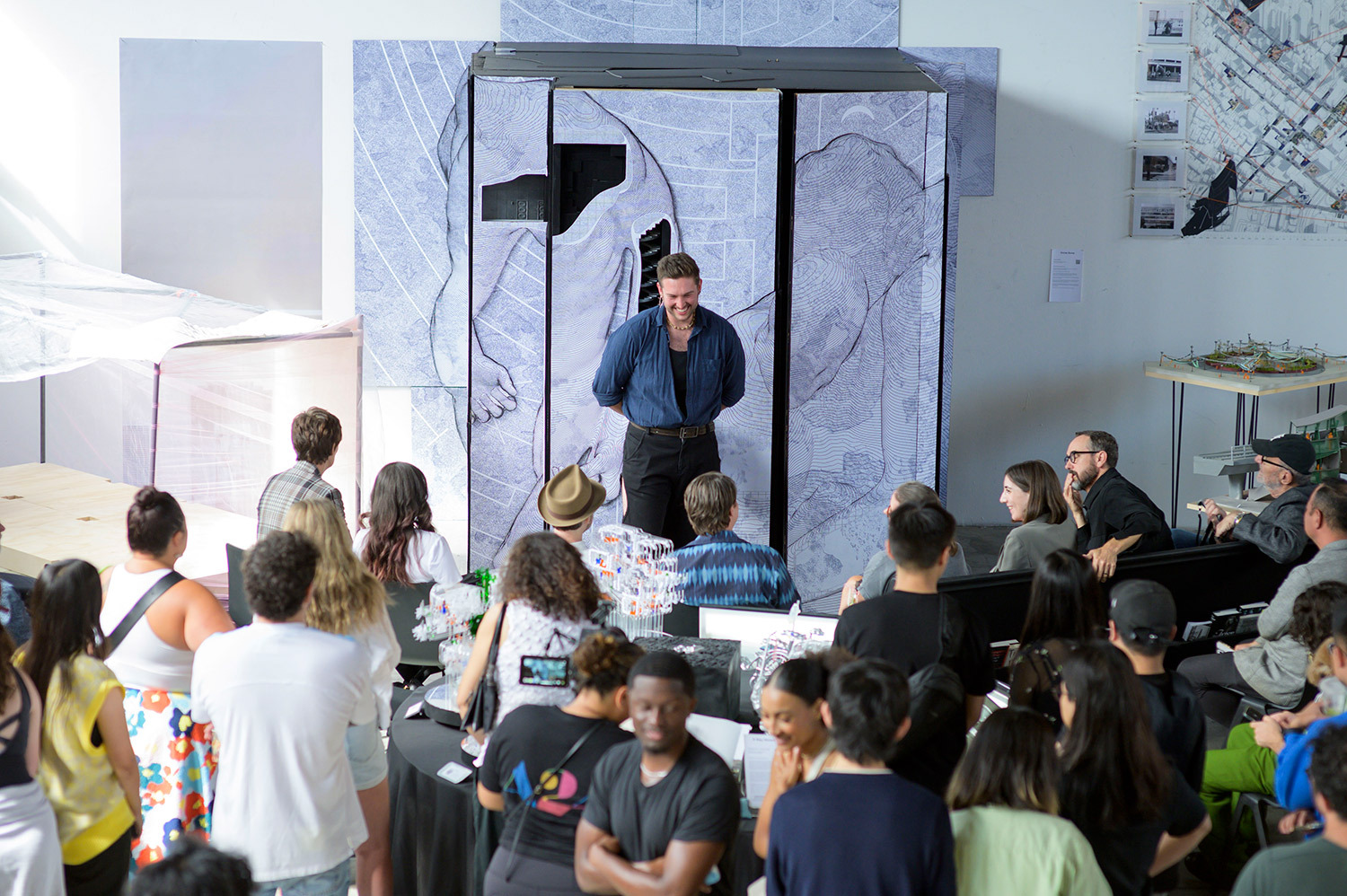
SCI-Arc Gehry Prize
For the best graduate thesis of the year, reflecting SCI-Arc’s core mission to test the limits of architecture.
Charite Carballo (M.Arch 1)
Advisor: Matthew Au
@CypheredThreads
Cyphered Threads
Encryption, Textile, Ritual, Material, Information, Community
A cipher is a system of encrypting and decrypting data. It is also an act of gathering and practicing craft.
Cyphered threads aims to relink craft and computation as a means to store the unreported data of invisible labor in technology. It seeks to distribute these accounts through the use of woven patterns and community ritual. The project intends to address the role of craft as an elevated art, architecture, and technology, while speaking to the notion of the unseen in regards to information and labor. Through the collection of inconspicuous cyphered surfaces and the creation of encoded environments, narratives will be encrypted to serve as a living record for a weaving collective.
Our transition from weaving to coding signifies that a pattern acts as a means to store information. Through this tracking of warp and weft patterns were translated to punch cards that gave way to the modern computer. History omits the mention of Ada Lovelace, a woman, who largely participated in the creation of this machine. Textile technology is often referred to as "women's work," specifically in the case of the Bauhaus. In truth it is the fundamental blueprint for today's technology. This thesis intends to disrupt the bias of textiles as decoration and to instead understand it as a tool to code, remember, and communicate.
The project will adopt the methods of codification from subverted textile technologies, specifically their ability to keep records for the community and store narratives. Patterns inherently hold associations through their attributed symbolism, and intonation. We can consider the basket weave to mean balance and duality or the Quipu knots to represent a certain numerical digit. To the untrained eye the textile is perceived as an inconspicuous object. Those in the know are able to decipher the code hiding in plain sight. Thread and colors conceal and filter these ciphers to create a smart textile.
The syntax is integral towards the dissemination of the visual language along with a series of grasshopper scripts that are used to create the pattern, loom, and instruction. This new material system intends to cultivate the need to congregate through the use of a new loom that receives and deploys the data. The gesture of the hand as a weaver and encrypter further informs the textiles meaning. This slow take of encryption and production is more valuable because it is sustainable, confidential, and identifiable. Material is understood as information and accounts for its labor, time, and meaning.
Man Shu (M.Arch 2)
Advisor: Karel Klein
@sookie_man_shu
The Pleasure of Architecture - The Architecture of Pleasure
What is the hidden, but powerful mechanism connecting eroticism and architecture?
How to inspire the individual's erotic imagination and activate the society's unconscious desire through the sensuousness of space?
What new role can erotic architecture take on in our urban society in the era of sexual liberation?
The Pleasure of Architecture:
“Architecture is the ultimate erotic act. Carry it to excess and it will reveal both the traces of reason and the sensual experience of space. Simultaneously.”
Bernard Tschumi,
Fragment 9: Architecture of Pleasure
Chapter 10: The Pleasure of Architecture,
What is Architecture?
Fragment 1: Architecture = Eroticism
Architecture is imagination by nature. Imagination is pornographic by nature. Taken to its extreme, architecture is the ultimate erotic act, which includes both pain and pleasure.
Fragment 2: Pain or Pleasure – the Sensuousness of Space
The ropes and rules of architecture have the erotic significance of bondage: the more numerous and sophisticated the restraints, the greater the pleasure. Thus, during the game of erotic space, the pleasure is the pain, the pain is the pleasure. The pain and pleasure of architecture is an unspoken experience of sensuousness, which lies in the form of formlessness, coming from loose fragments representing erotic significance.
Fragment 3: The Pleasure of Eroticism
The pleasure of eroticism lies in the erotic relationship between architecture and architecture, which can be perceived as a kind of spiritual sensuality. Although palpable sexual tension exists between these entities, their consummation is often deferred or remains unrealized. The erotic sensation between architecture and its audience assumes a seemingly effortless yet meticulously orchestrated equilibrium, akin to the art of pole dancing. These moments of touching and gestures evoke a profound pleasure response.
Fragment 4: The Pain of Memorial
What is the pain of architecture? How to address both the pleasure and pain of spatial sensuousness through the erotic form at the same time? Physically, it has nothing to do with the symbolic form of the body, it lies in the tortured surface, the seductive line, the prickly point. Spiritually, it can be gained from the meaning of the memorial form. The memorial form is the representation of the cautionary form, the reflection of sexual risk. Simultaneously, it is a commemoration and tribute to the erotic experiences of space. Involving the structure of space, it helps evoke feelings of sensuality and celebrate the expression of human sexuality.
Fragment 5: The Climax of Fragments
The pleasure of architecture achieves climax ultimately, when the erotic fragments abruptly collide and merge in delight, all the rules are disproved, limits are perverted, prohibitions are transgressed, typologies, morphologies, spatial compressions, logical constructions - all dissolved. The starting point of architecture is distortion which is the most forbidden parts of the architecture act. Such architecture is perverse because its real significance lies outside utility or purpose and ultimately is not even necessarily aimed at giving pleasure.
A word of Warning. A piece of erotic architecture is architectural not because it fulfills some utilitarian function, but because it inspires erotic imagination, suggests seduction, activate the society's and individual's unconscious desires.
The Architecture of Pleasure:
Want Pleasure? Go to the Memorial!
The 10,000 m2 of Desire
The Ukiyo-e of Libido
The project is a public/non-private playground for adults’ collective engagement in sexual recreation. It is a spatial embodiment of sexual equity and liberation. Although combined with the memorial for persecuted women in Yoshiwara Yukaku. It is not a cemetery. Guilt or sadness is not the goal. It is a cautionary memorial against sexual exploitation. The sensuousness of space (pain or pleasure) is the destination. Sexuality can be freely expressed and celebrated in this inclusive environment. It is the Ukiyo-e of libido in the era of sexual liberation, inspiring erotic imagination and unspoken desires of society and individuals.
Yoshiwara Yukaku: 1617-1958, one of the three licensed and well-known pleasure quarters in Edo, present-day Tokyo. It was a vibrant and bustling area known for its entertainment, including brothels, theaters, teahouses, restaurants, etc.
Ukiyo: 'floating/fleeting/transient world', describes the urban lifestyle and culture of pleasure-seeking aspects, of Edo period Japan
